Critical Analysis of the Procurement System for CBD and South East Light Rail
VerifiedAdded on 2022/08/19
|18
|4620
|31
AI Summary
Discussion 5 2.1 Brief Description of the Case Study of CBD and South East Light Rail Project, Sydney NSW 5 2.2 Identification of the Alternative Procurement System 6 2.2.1 Design Bid Build 7 2.2.2 Design and Construct Method 7 2.2.3 Public-Private Partnership 8 2.2.4 Early Contractor Involvement 8 2.2.5 Partnering 8 2.3 Development of the Selection Criteria of a Procurement System 9 2.3.1 Quality Level 9 2.3.2 Speed 9 2.3.3 Flexibility for Changes 10 2.3.4 Technology Usage
Contribute Materials
Your contribution can guide someone’s learning journey. Share your
documents today.
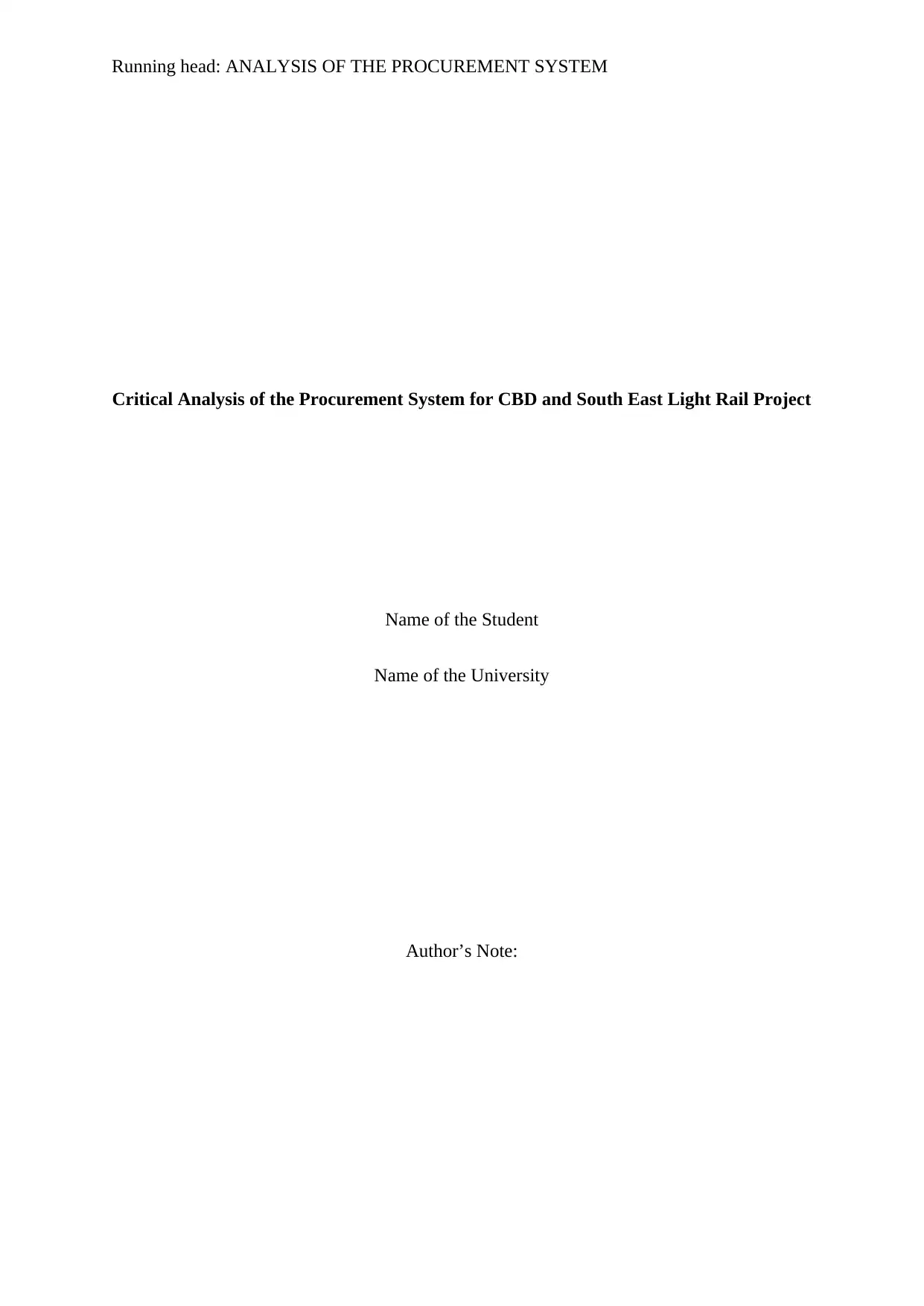
Running head: ANALYSIS OF THE PROCUREMENT SYSTEM
Critical Analysis of the Procurement System for CBD and South East Light Rail Project
Name of the Student
Name of the University
Author’s Note:
Critical Analysis of the Procurement System for CBD and South East Light Rail Project
Name of the Student
Name of the University
Author’s Note:
Secure Best Marks with AI Grader
Need help grading? Try our AI Grader for instant feedback on your assignments.
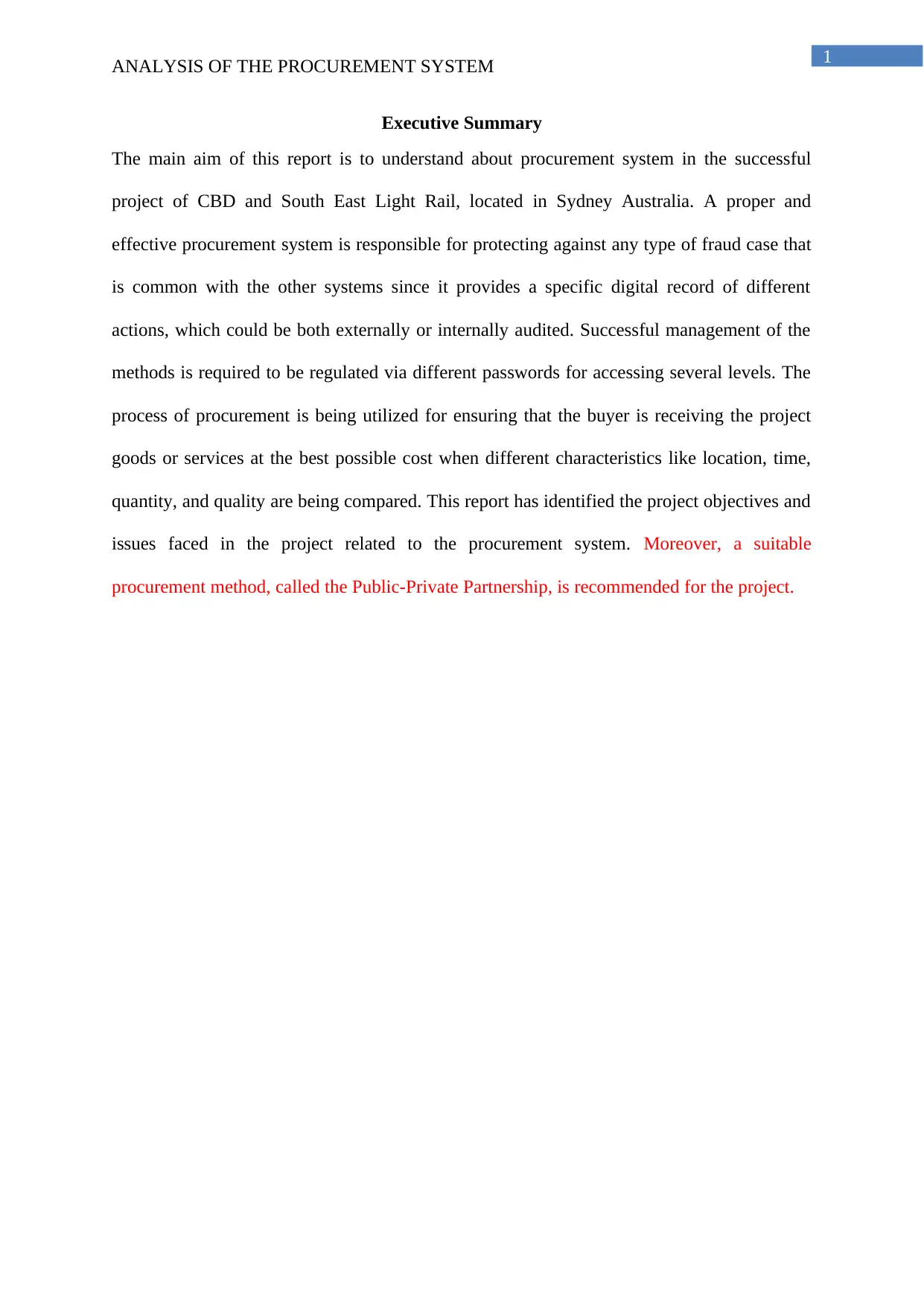
1
ANALYSIS OF THE PROCUREMENT SYSTEM
Executive Summary
The main aim of this report is to understand about procurement system in the successful
project of CBD and South East Light Rail, located in Sydney Australia. A proper and
effective procurement system is responsible for protecting against any type of fraud case that
is common with the other systems since it provides a specific digital record of different
actions, which could be both externally or internally audited. Successful management of the
methods is required to be regulated via different passwords for accessing several levels. The
process of procurement is being utilized for ensuring that the buyer is receiving the project
goods or services at the best possible cost when different characteristics like location, time,
quantity, and quality are being compared. This report has identified the project objectives and
issues faced in the project related to the procurement system. Moreover, a suitable
procurement method, called the Public-Private Partnership, is recommended for the project.
ANALYSIS OF THE PROCUREMENT SYSTEM
Executive Summary
The main aim of this report is to understand about procurement system in the successful
project of CBD and South East Light Rail, located in Sydney Australia. A proper and
effective procurement system is responsible for protecting against any type of fraud case that
is common with the other systems since it provides a specific digital record of different
actions, which could be both externally or internally audited. Successful management of the
methods is required to be regulated via different passwords for accessing several levels. The
process of procurement is being utilized for ensuring that the buyer is receiving the project
goods or services at the best possible cost when different characteristics like location, time,
quantity, and quality are being compared. This report has identified the project objectives and
issues faced in the project related to the procurement system. Moreover, a suitable
procurement method, called the Public-Private Partnership, is recommended for the project.
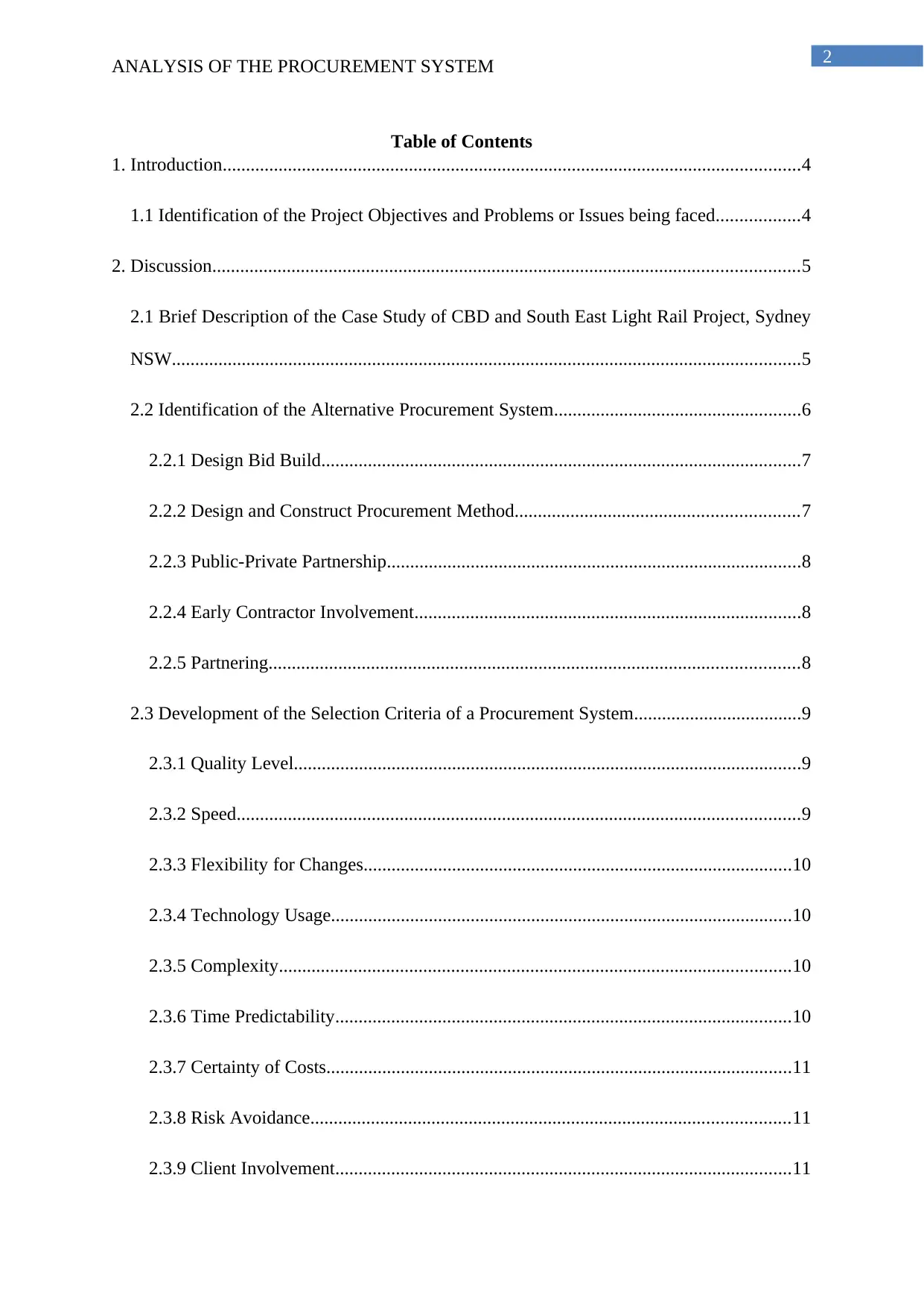
2
ANALYSIS OF THE PROCUREMENT SYSTEM
Table of Contents
1. Introduction............................................................................................................................4
1.1 Identification of the Project Objectives and Problems or Issues being faced..................4
2. Discussion..............................................................................................................................5
2.1 Brief Description of the Case Study of CBD and South East Light Rail Project, Sydney
NSW.......................................................................................................................................5
2.2 Identification of the Alternative Procurement System.....................................................6
2.2.1 Design Bid Build.......................................................................................................7
2.2.2 Design and Construct Procurement Method.............................................................7
2.2.3 Public-Private Partnership.........................................................................................8
2.2.4 Early Contractor Involvement...................................................................................8
2.2.5 Partnering..................................................................................................................8
2.3 Development of the Selection Criteria of a Procurement System....................................9
2.3.1 Quality Level.............................................................................................................9
2.3.2 Speed.........................................................................................................................9
2.3.3 Flexibility for Changes............................................................................................10
2.3.4 Technology Usage...................................................................................................10
2.3.5 Complexity..............................................................................................................10
2.3.6 Time Predictability..................................................................................................10
2.3.7 Certainty of Costs....................................................................................................11
2.3.8 Risk Avoidance.......................................................................................................11
2.3.9 Client Involvement..................................................................................................11
ANALYSIS OF THE PROCUREMENT SYSTEM
Table of Contents
1. Introduction............................................................................................................................4
1.1 Identification of the Project Objectives and Problems or Issues being faced..................4
2. Discussion..............................................................................................................................5
2.1 Brief Description of the Case Study of CBD and South East Light Rail Project, Sydney
NSW.......................................................................................................................................5
2.2 Identification of the Alternative Procurement System.....................................................6
2.2.1 Design Bid Build.......................................................................................................7
2.2.2 Design and Construct Procurement Method.............................................................7
2.2.3 Public-Private Partnership.........................................................................................8
2.2.4 Early Contractor Involvement...................................................................................8
2.2.5 Partnering..................................................................................................................8
2.3 Development of the Selection Criteria of a Procurement System....................................9
2.3.1 Quality Level.............................................................................................................9
2.3.2 Speed.........................................................................................................................9
2.3.3 Flexibility for Changes............................................................................................10
2.3.4 Technology Usage...................................................................................................10
2.3.5 Complexity..............................................................................................................10
2.3.6 Time Predictability..................................................................................................10
2.3.7 Certainty of Costs....................................................................................................11
2.3.8 Risk Avoidance.......................................................................................................11
2.3.9 Client Involvement..................................................................................................11
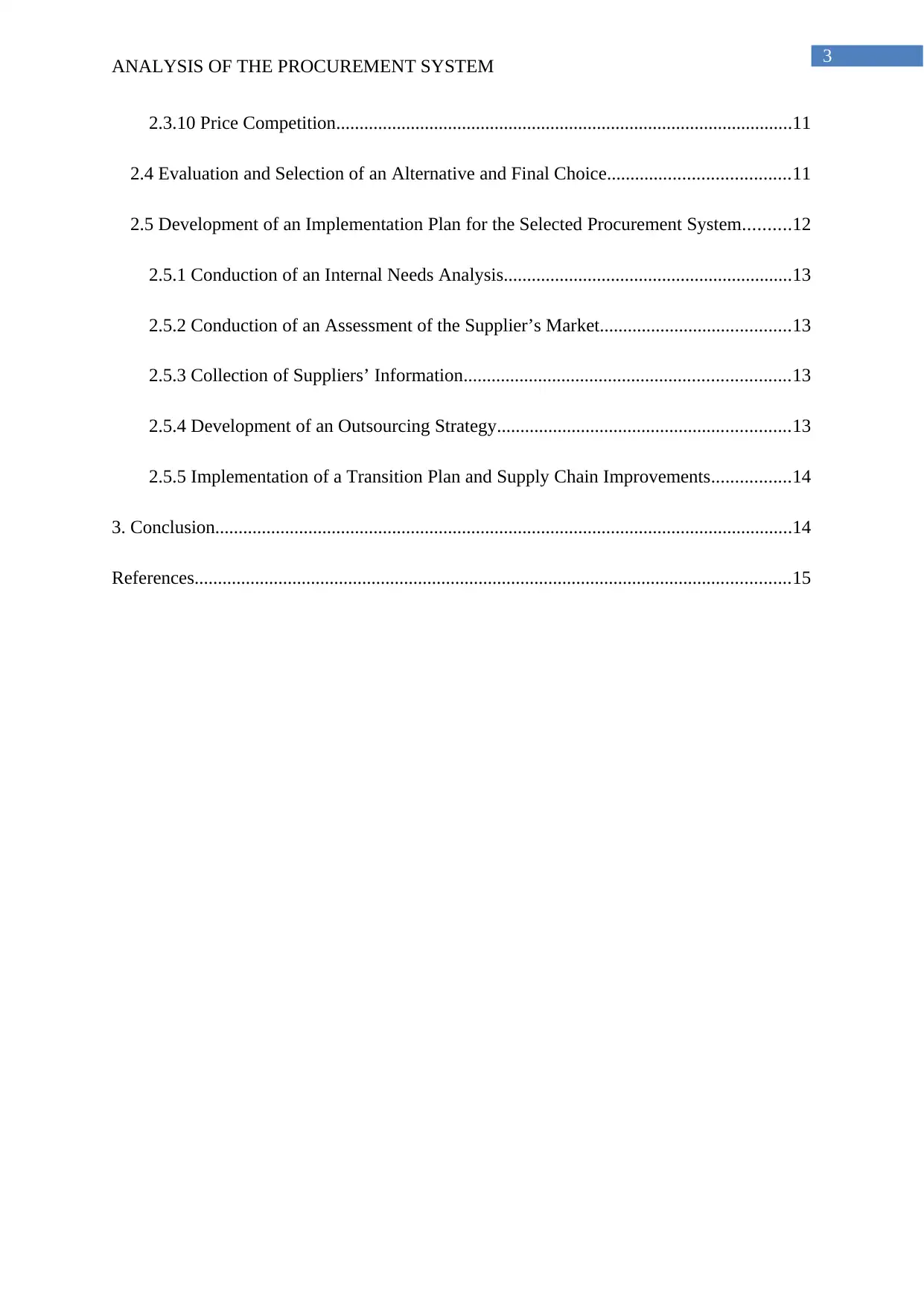
3
ANALYSIS OF THE PROCUREMENT SYSTEM
2.3.10 Price Competition..................................................................................................11
2.4 Evaluation and Selection of an Alternative and Final Choice.......................................11
2.5 Development of an Implementation Plan for the Selected Procurement System..........12
2.5.1 Conduction of an Internal Needs Analysis..............................................................13
2.5.2 Conduction of an Assessment of the Supplier’s Market.........................................13
2.5.3 Collection of Suppliers’ Information......................................................................13
2.5.4 Development of an Outsourcing Strategy...............................................................13
2.5.5 Implementation of a Transition Plan and Supply Chain Improvements.................14
3. Conclusion............................................................................................................................14
References................................................................................................................................15
ANALYSIS OF THE PROCUREMENT SYSTEM
2.3.10 Price Competition..................................................................................................11
2.4 Evaluation and Selection of an Alternative and Final Choice.......................................11
2.5 Development of an Implementation Plan for the Selected Procurement System..........12
2.5.1 Conduction of an Internal Needs Analysis..............................................................13
2.5.2 Conduction of an Assessment of the Supplier’s Market.........................................13
2.5.3 Collection of Suppliers’ Information......................................................................13
2.5.4 Development of an Outsourcing Strategy...............................................................13
2.5.5 Implementation of a Transition Plan and Supply Chain Improvements.................14
3. Conclusion............................................................................................................................14
References................................................................................................................................15
Secure Best Marks with AI Grader
Need help grading? Try our AI Grader for instant feedback on your assignments.
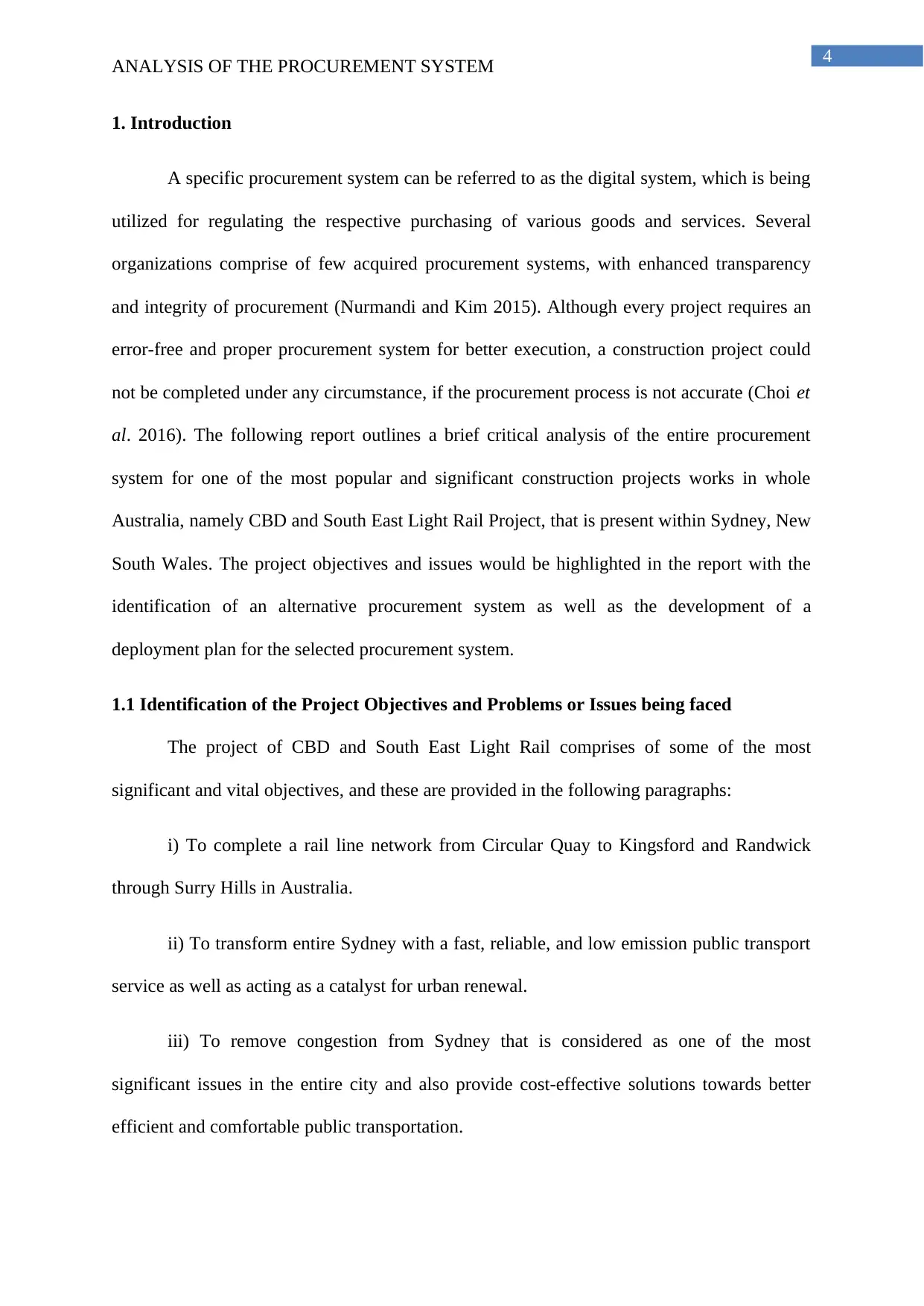
4
ANALYSIS OF THE PROCUREMENT SYSTEM
1. Introduction
A specific procurement system can be referred to as the digital system, which is being
utilized for regulating the respective purchasing of various goods and services. Several
organizations comprise of few acquired procurement systems, with enhanced transparency
and integrity of procurement (Nurmandi and Kim 2015). Although every project requires an
error-free and proper procurement system for better execution, a construction project could
not be completed under any circumstance, if the procurement process is not accurate (Choi et
al. 2016). The following report outlines a brief critical analysis of the entire procurement
system for one of the most popular and significant construction projects works in whole
Australia, namely CBD and South East Light Rail Project, that is present within Sydney, New
South Wales. The project objectives and issues would be highlighted in the report with the
identification of an alternative procurement system as well as the development of a
deployment plan for the selected procurement system.
1.1 Identification of the Project Objectives and Problems or Issues being faced
The project of CBD and South East Light Rail comprises of some of the most
significant and vital objectives, and these are provided in the following paragraphs:
i) To complete a rail line network from Circular Quay to Kingsford and Randwick
through Surry Hills in Australia.
ii) To transform entire Sydney with a fast, reliable, and low emission public transport
service as well as acting as a catalyst for urban renewal.
iii) To remove congestion from Sydney that is considered as one of the most
significant issues in the entire city and also provide cost-effective solutions towards better
efficient and comfortable public transportation.
ANALYSIS OF THE PROCUREMENT SYSTEM
1. Introduction
A specific procurement system can be referred to as the digital system, which is being
utilized for regulating the respective purchasing of various goods and services. Several
organizations comprise of few acquired procurement systems, with enhanced transparency
and integrity of procurement (Nurmandi and Kim 2015). Although every project requires an
error-free and proper procurement system for better execution, a construction project could
not be completed under any circumstance, if the procurement process is not accurate (Choi et
al. 2016). The following report outlines a brief critical analysis of the entire procurement
system for one of the most popular and significant construction projects works in whole
Australia, namely CBD and South East Light Rail Project, that is present within Sydney, New
South Wales. The project objectives and issues would be highlighted in the report with the
identification of an alternative procurement system as well as the development of a
deployment plan for the selected procurement system.
1.1 Identification of the Project Objectives and Problems or Issues being faced
The project of CBD and South East Light Rail comprises of some of the most
significant and vital objectives, and these are provided in the following paragraphs:
i) To complete a rail line network from Circular Quay to Kingsford and Randwick
through Surry Hills in Australia.
ii) To transform entire Sydney with a fast, reliable, and low emission public transport
service as well as acting as a catalyst for urban renewal.
iii) To remove congestion from Sydney that is considered as one of the most
significant issues in the entire city and also provide cost-effective solutions towards better
efficient and comfortable public transportation.

5
ANALYSIS OF THE PROCUREMENT SYSTEM
iv) To improve amenities in the town by providing a world-class pedestrian boulevard
for Sydney on George Street.
Although the project was expected to bring out some of the most essential and
noteworthy advantages for the entire Sydney, transportation for NSW did not correctly plan
or procure the project work of South East Light Rail for achieving the best values for money.
The respectively established assurance framework had to undertake the reviews of assurance
for the project work (Sydney Light Rail Public-Private Partnership. 2015). However, the
approach did not provide the respective independent assurance needed for the construction
project work. Tight timeframes were not proper as well as the normalized governance
systems were not present initially in place.
Moreover, this particular project work has also faced issues related to planning and
evaluation. During the planning phases, Transportation for NSW had to improve the
governance and assurance framework of this specific project work. They even had to deploy
a few monthly assessments to monitor different risks, which could eventually affect their
budget and timeframe (Transport for NSW. 2017). The organization has faced various issues
in its procurement management, such as supplier or selection of procurement route. As a
result, there were few of the risks related to costs and time management, and they even had
faced an issue of long procurement cycle as well as inaccurate data.
2. Discussion
2.1 Brief Description of the Case Study of CBD and South East Light Rail Project,
Sydney NSW
The CBD and South East Light Rail Project is a significant partially opened light
railway track within Sydney, NSW in Australia. The rail line runs from the Circular Quay at
the north end of their centralized business district to the several South East suburbs of
ANALYSIS OF THE PROCUREMENT SYSTEM
iv) To improve amenities in the town by providing a world-class pedestrian boulevard
for Sydney on George Street.
Although the project was expected to bring out some of the most essential and
noteworthy advantages for the entire Sydney, transportation for NSW did not correctly plan
or procure the project work of South East Light Rail for achieving the best values for money.
The respectively established assurance framework had to undertake the reviews of assurance
for the project work (Sydney Light Rail Public-Private Partnership. 2015). However, the
approach did not provide the respective independent assurance needed for the construction
project work. Tight timeframes were not proper as well as the normalized governance
systems were not present initially in place.
Moreover, this particular project work has also faced issues related to planning and
evaluation. During the planning phases, Transportation for NSW had to improve the
governance and assurance framework of this specific project work. They even had to deploy
a few monthly assessments to monitor different risks, which could eventually affect their
budget and timeframe (Transport for NSW. 2017). The organization has faced various issues
in its procurement management, such as supplier or selection of procurement route. As a
result, there were few of the risks related to costs and time management, and they even had
faced an issue of long procurement cycle as well as inaccurate data.
2. Discussion
2.1 Brief Description of the Case Study of CBD and South East Light Rail Project,
Sydney NSW
The CBD and South East Light Rail Project is a significant partially opened light
railway track within Sydney, NSW in Australia. The rail line runs from the Circular Quay at
the north end of their centralized business district to the several South East suburbs of
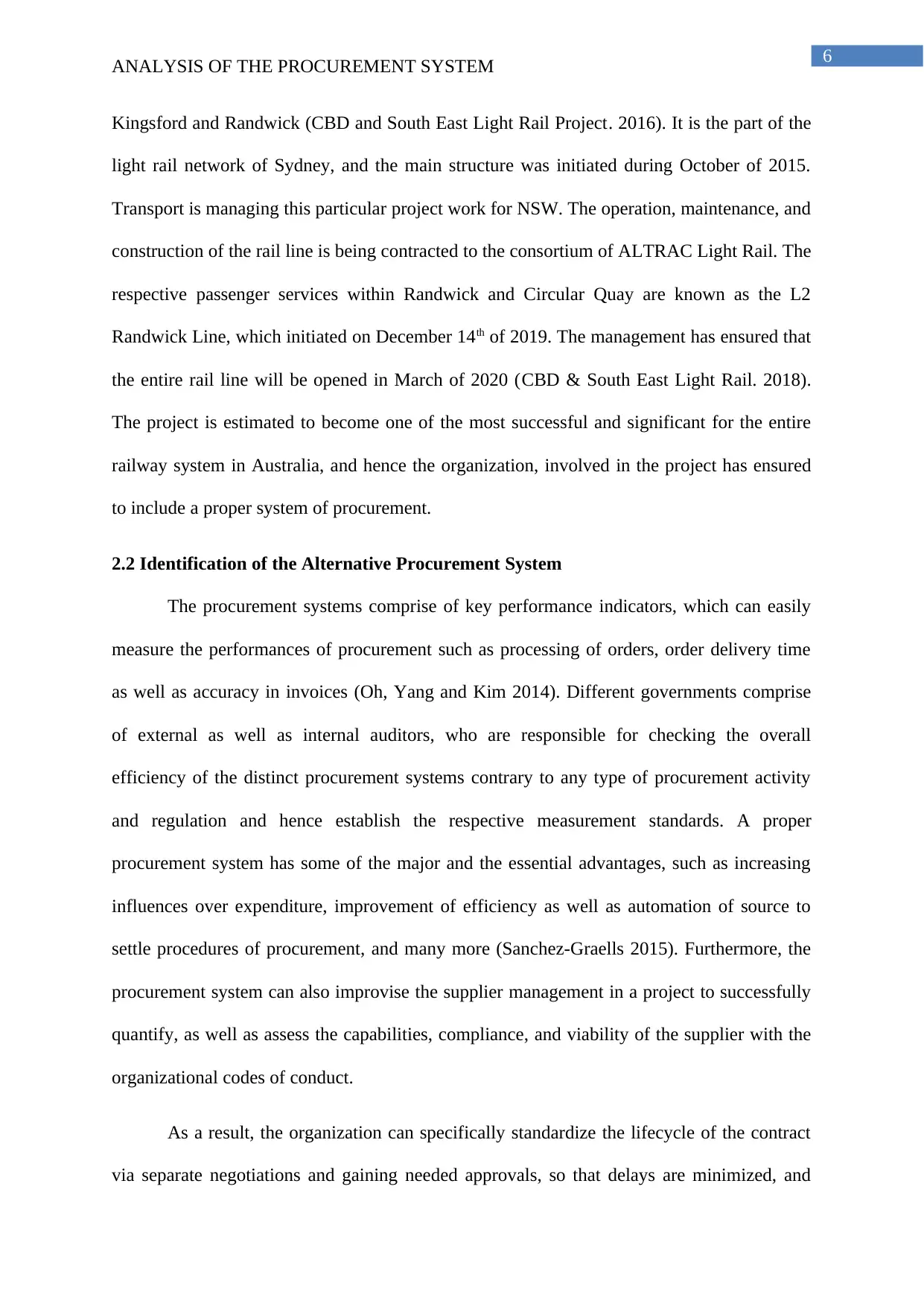
6
ANALYSIS OF THE PROCUREMENT SYSTEM
Kingsford and Randwick (CBD and South East Light Rail Project. 2016). It is the part of the
light rail network of Sydney, and the main structure was initiated during October of 2015.
Transport is managing this particular project work for NSW. The operation, maintenance, and
construction of the rail line is being contracted to the consortium of ALTRAC Light Rail. The
respective passenger services within Randwick and Circular Quay are known as the L2
Randwick Line, which initiated on December 14th of 2019. The management has ensured that
the entire rail line will be opened in March of 2020 (CBD & South East Light Rail. 2018).
The project is estimated to become one of the most successful and significant for the entire
railway system in Australia, and hence the organization, involved in the project has ensured
to include a proper system of procurement.
2.2 Identification of the Alternative Procurement System
The procurement systems comprise of key performance indicators, which can easily
measure the performances of procurement such as processing of orders, order delivery time
as well as accuracy in invoices (Oh, Yang and Kim 2014). Different governments comprise
of external as well as internal auditors, who are responsible for checking the overall
efficiency of the distinct procurement systems contrary to any type of procurement activity
and regulation and hence establish the respective measurement standards. A proper
procurement system has some of the major and the essential advantages, such as increasing
influences over expenditure, improvement of efficiency as well as automation of source to
settle procedures of procurement, and many more (Sanchez-Graells 2015). Furthermore, the
procurement system can also improvise the supplier management in a project to successfully
quantify, as well as assess the capabilities, compliance, and viability of the supplier with the
organizational codes of conduct.
As a result, the organization can specifically standardize the lifecycle of the contract
via separate negotiations and gaining needed approvals, so that delays are minimized, and
ANALYSIS OF THE PROCUREMENT SYSTEM
Kingsford and Randwick (CBD and South East Light Rail Project. 2016). It is the part of the
light rail network of Sydney, and the main structure was initiated during October of 2015.
Transport is managing this particular project work for NSW. The operation, maintenance, and
construction of the rail line is being contracted to the consortium of ALTRAC Light Rail. The
respective passenger services within Randwick and Circular Quay are known as the L2
Randwick Line, which initiated on December 14th of 2019. The management has ensured that
the entire rail line will be opened in March of 2020 (CBD & South East Light Rail. 2018).
The project is estimated to become one of the most successful and significant for the entire
railway system in Australia, and hence the organization, involved in the project has ensured
to include a proper system of procurement.
2.2 Identification of the Alternative Procurement System
The procurement systems comprise of key performance indicators, which can easily
measure the performances of procurement such as processing of orders, order delivery time
as well as accuracy in invoices (Oh, Yang and Kim 2014). Different governments comprise
of external as well as internal auditors, who are responsible for checking the overall
efficiency of the distinct procurement systems contrary to any type of procurement activity
and regulation and hence establish the respective measurement standards. A proper
procurement system has some of the major and the essential advantages, such as increasing
influences over expenditure, improvement of efficiency as well as automation of source to
settle procedures of procurement, and many more (Sanchez-Graells 2015). Furthermore, the
procurement system can also improvise the supplier management in a project to successfully
quantify, as well as assess the capabilities, compliance, and viability of the supplier with the
organizational codes of conduct.
As a result, the organization can specifically standardize the lifecycle of the contract
via separate negotiations and gaining needed approvals, so that delays are minimized, and
Paraphrase This Document
Need a fresh take? Get an instant paraphrase of this document with our AI Paraphraser
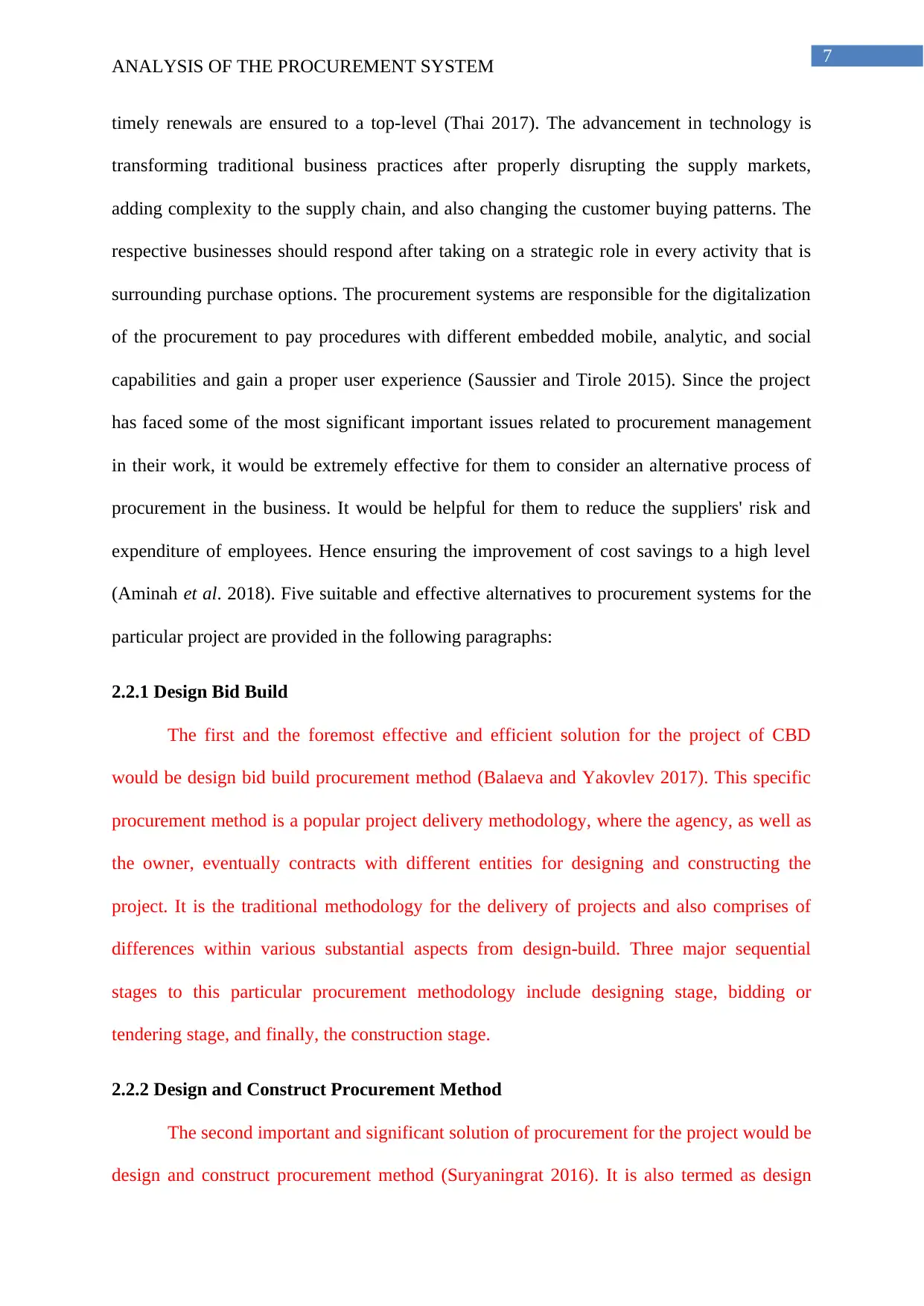
7
ANALYSIS OF THE PROCUREMENT SYSTEM
timely renewals are ensured to a top-level (Thai 2017). The advancement in technology is
transforming traditional business practices after properly disrupting the supply markets,
adding complexity to the supply chain, and also changing the customer buying patterns. The
respective businesses should respond after taking on a strategic role in every activity that is
surrounding purchase options. The procurement systems are responsible for the digitalization
of the procurement to pay procedures with different embedded mobile, analytic, and social
capabilities and gain a proper user experience (Saussier and Tirole 2015). Since the project
has faced some of the most significant important issues related to procurement management
in their work, it would be extremely effective for them to consider an alternative process of
procurement in the business. It would be helpful for them to reduce the suppliers' risk and
expenditure of employees. Hence ensuring the improvement of cost savings to a high level
(Aminah et al. 2018). Five suitable and effective alternatives to procurement systems for the
particular project are provided in the following paragraphs:
2.2.1 Design Bid Build
The first and the foremost effective and efficient solution for the project of CBD
would be design bid build procurement method (Balaeva and Yakovlev 2017). This specific
procurement method is a popular project delivery methodology, where the agency, as well as
the owner, eventually contracts with different entities for designing and constructing the
project. It is the traditional methodology for the delivery of projects and also comprises of
differences within various substantial aspects from design-build. Three major sequential
stages to this particular procurement methodology include designing stage, bidding or
tendering stage, and finally, the construction stage.
2.2.2 Design and Construct Procurement Method
The second important and significant solution of procurement for the project would be
design and construct procurement method (Suryaningrat 2016). It is also termed as design
ANALYSIS OF THE PROCUREMENT SYSTEM
timely renewals are ensured to a top-level (Thai 2017). The advancement in technology is
transforming traditional business practices after properly disrupting the supply markets,
adding complexity to the supply chain, and also changing the customer buying patterns. The
respective businesses should respond after taking on a strategic role in every activity that is
surrounding purchase options. The procurement systems are responsible for the digitalization
of the procurement to pay procedures with different embedded mobile, analytic, and social
capabilities and gain a proper user experience (Saussier and Tirole 2015). Since the project
has faced some of the most significant important issues related to procurement management
in their work, it would be extremely effective for them to consider an alternative process of
procurement in the business. It would be helpful for them to reduce the suppliers' risk and
expenditure of employees. Hence ensuring the improvement of cost savings to a high level
(Aminah et al. 2018). Five suitable and effective alternatives to procurement systems for the
particular project are provided in the following paragraphs:
2.2.1 Design Bid Build
The first and the foremost effective and efficient solution for the project of CBD
would be design bid build procurement method (Balaeva and Yakovlev 2017). This specific
procurement method is a popular project delivery methodology, where the agency, as well as
the owner, eventually contracts with different entities for designing and constructing the
project. It is the traditional methodology for the delivery of projects and also comprises of
differences within various substantial aspects from design-build. Three major sequential
stages to this particular procurement methodology include designing stage, bidding or
tendering stage, and finally, the construction stage.
2.2.2 Design and Construct Procurement Method
The second important and significant solution of procurement for the project would be
design and construct procurement method (Suryaningrat 2016). It is also termed as design
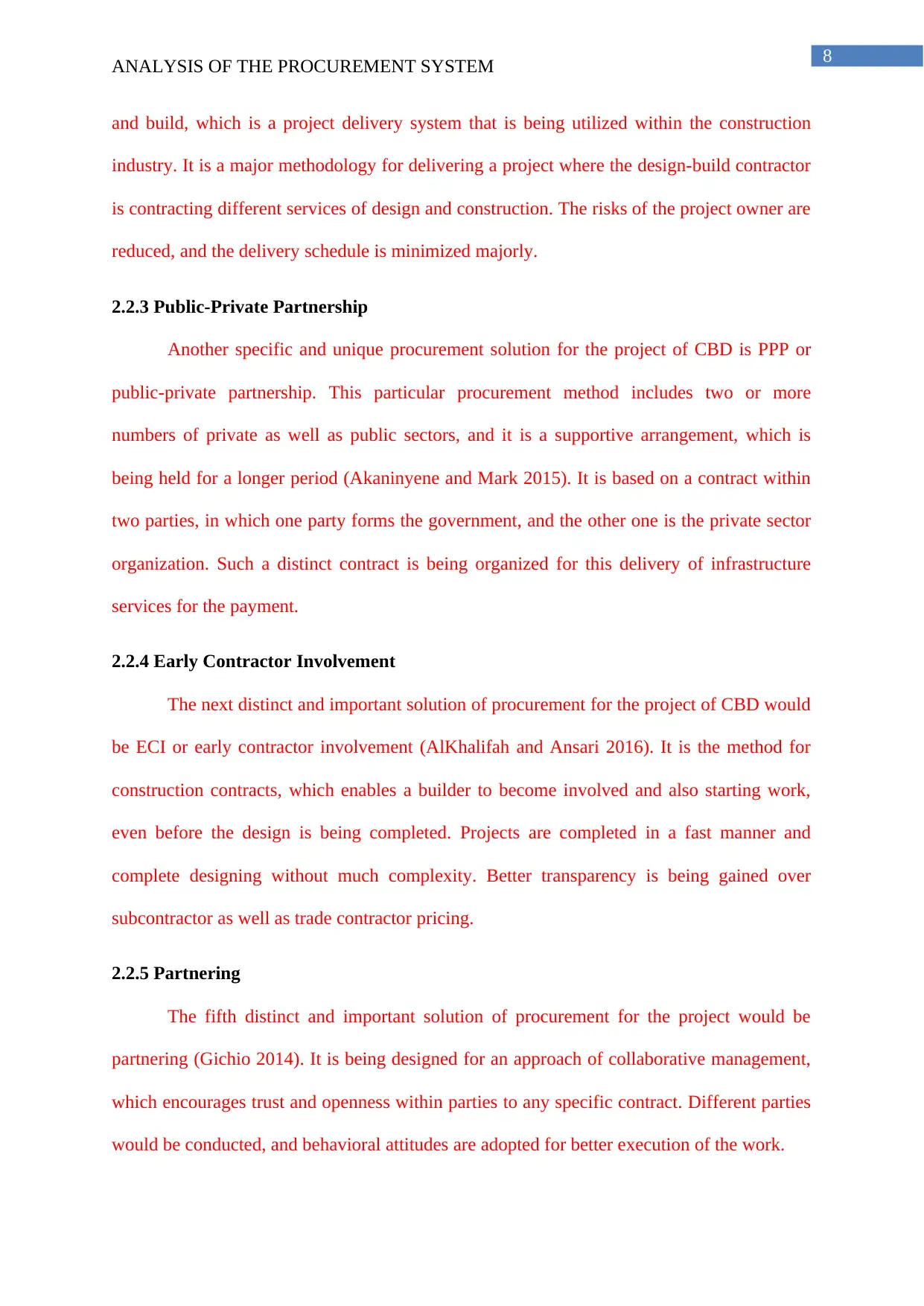
8
ANALYSIS OF THE PROCUREMENT SYSTEM
and build, which is a project delivery system that is being utilized within the construction
industry. It is a major methodology for delivering a project where the design-build contractor
is contracting different services of design and construction. The risks of the project owner are
reduced, and the delivery schedule is minimized majorly.
2.2.3 Public-Private Partnership
Another specific and unique procurement solution for the project of CBD is PPP or
public-private partnership. This particular procurement method includes two or more
numbers of private as well as public sectors, and it is a supportive arrangement, which is
being held for a longer period (Akaninyene and Mark 2015). It is based on a contract within
two parties, in which one party forms the government, and the other one is the private sector
organization. Such a distinct contract is being organized for this delivery of infrastructure
services for the payment.
2.2.4 Early Contractor Involvement
The next distinct and important solution of procurement for the project of CBD would
be ECI or early contractor involvement (AlKhalifah and Ansari 2016). It is the method for
construction contracts, which enables a builder to become involved and also starting work,
even before the design is being completed. Projects are completed in a fast manner and
complete designing without much complexity. Better transparency is being gained over
subcontractor as well as trade contractor pricing.
2.2.5 Partnering
The fifth distinct and important solution of procurement for the project would be
partnering (Gichio 2014). It is being designed for an approach of collaborative management,
which encourages trust and openness within parties to any specific contract. Different parties
would be conducted, and behavioral attitudes are adopted for better execution of the work.
ANALYSIS OF THE PROCUREMENT SYSTEM
and build, which is a project delivery system that is being utilized within the construction
industry. It is a major methodology for delivering a project where the design-build contractor
is contracting different services of design and construction. The risks of the project owner are
reduced, and the delivery schedule is minimized majorly.
2.2.3 Public-Private Partnership
Another specific and unique procurement solution for the project of CBD is PPP or
public-private partnership. This particular procurement method includes two or more
numbers of private as well as public sectors, and it is a supportive arrangement, which is
being held for a longer period (Akaninyene and Mark 2015). It is based on a contract within
two parties, in which one party forms the government, and the other one is the private sector
organization. Such a distinct contract is being organized for this delivery of infrastructure
services for the payment.
2.2.4 Early Contractor Involvement
The next distinct and important solution of procurement for the project of CBD would
be ECI or early contractor involvement (AlKhalifah and Ansari 2016). It is the method for
construction contracts, which enables a builder to become involved and also starting work,
even before the design is being completed. Projects are completed in a fast manner and
complete designing without much complexity. Better transparency is being gained over
subcontractor as well as trade contractor pricing.
2.2.5 Partnering
The fifth distinct and important solution of procurement for the project would be
partnering (Gichio 2014). It is being designed for an approach of collaborative management,
which encourages trust and openness within parties to any specific contract. Different parties
would be conducted, and behavioral attitudes are adopted for better execution of the work.
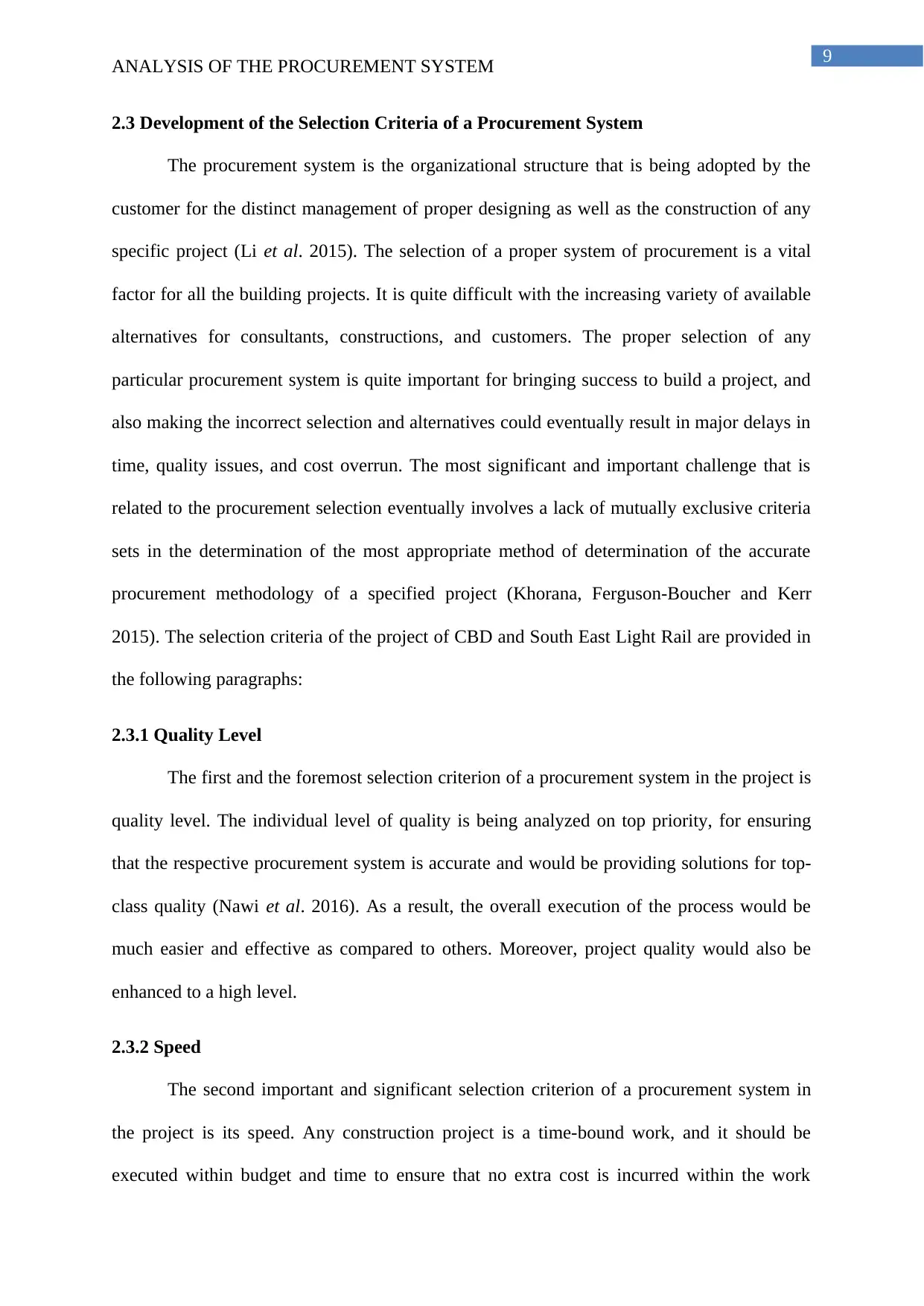
9
ANALYSIS OF THE PROCUREMENT SYSTEM
2.3 Development of the Selection Criteria of a Procurement System
The procurement system is the organizational structure that is being adopted by the
customer for the distinct management of proper designing as well as the construction of any
specific project (Li et al. 2015). The selection of a proper system of procurement is a vital
factor for all the building projects. It is quite difficult with the increasing variety of available
alternatives for consultants, constructions, and customers. The proper selection of any
particular procurement system is quite important for bringing success to build a project, and
also making the incorrect selection and alternatives could eventually result in major delays in
time, quality issues, and cost overrun. The most significant and important challenge that is
related to the procurement selection eventually involves a lack of mutually exclusive criteria
sets in the determination of the most appropriate method of determination of the accurate
procurement methodology of a specified project (Khorana, Ferguson‐Boucher and Kerr
2015). The selection criteria of the project of CBD and South East Light Rail are provided in
the following paragraphs:
2.3.1 Quality Level
The first and the foremost selection criterion of a procurement system in the project is
quality level. The individual level of quality is being analyzed on top priority, for ensuring
that the respective procurement system is accurate and would be providing solutions for top-
class quality (Nawi et al. 2016). As a result, the overall execution of the process would be
much easier and effective as compared to others. Moreover, project quality would also be
enhanced to a high level.
2.3.2 Speed
The second important and significant selection criterion of a procurement system in
the project is its speed. Any construction project is a time-bound work, and it should be
executed within budget and time to ensure that no extra cost is incurred within the work
ANALYSIS OF THE PROCUREMENT SYSTEM
2.3 Development of the Selection Criteria of a Procurement System
The procurement system is the organizational structure that is being adopted by the
customer for the distinct management of proper designing as well as the construction of any
specific project (Li et al. 2015). The selection of a proper system of procurement is a vital
factor for all the building projects. It is quite difficult with the increasing variety of available
alternatives for consultants, constructions, and customers. The proper selection of any
particular procurement system is quite important for bringing success to build a project, and
also making the incorrect selection and alternatives could eventually result in major delays in
time, quality issues, and cost overrun. The most significant and important challenge that is
related to the procurement selection eventually involves a lack of mutually exclusive criteria
sets in the determination of the most appropriate method of determination of the accurate
procurement methodology of a specified project (Khorana, Ferguson‐Boucher and Kerr
2015). The selection criteria of the project of CBD and South East Light Rail are provided in
the following paragraphs:
2.3.1 Quality Level
The first and the foremost selection criterion of a procurement system in the project is
quality level. The individual level of quality is being analyzed on top priority, for ensuring
that the respective procurement system is accurate and would be providing solutions for top-
class quality (Nawi et al. 2016). As a result, the overall execution of the process would be
much easier and effective as compared to others. Moreover, project quality would also be
enhanced to a high level.
2.3.2 Speed
The second important and significant selection criterion of a procurement system in
the project is its speed. Any construction project is a time-bound work, and it should be
executed within budget and time to ensure that no extra cost is incurred within the work
Secure Best Marks with AI Grader
Need help grading? Try our AI Grader for instant feedback on your assignments.
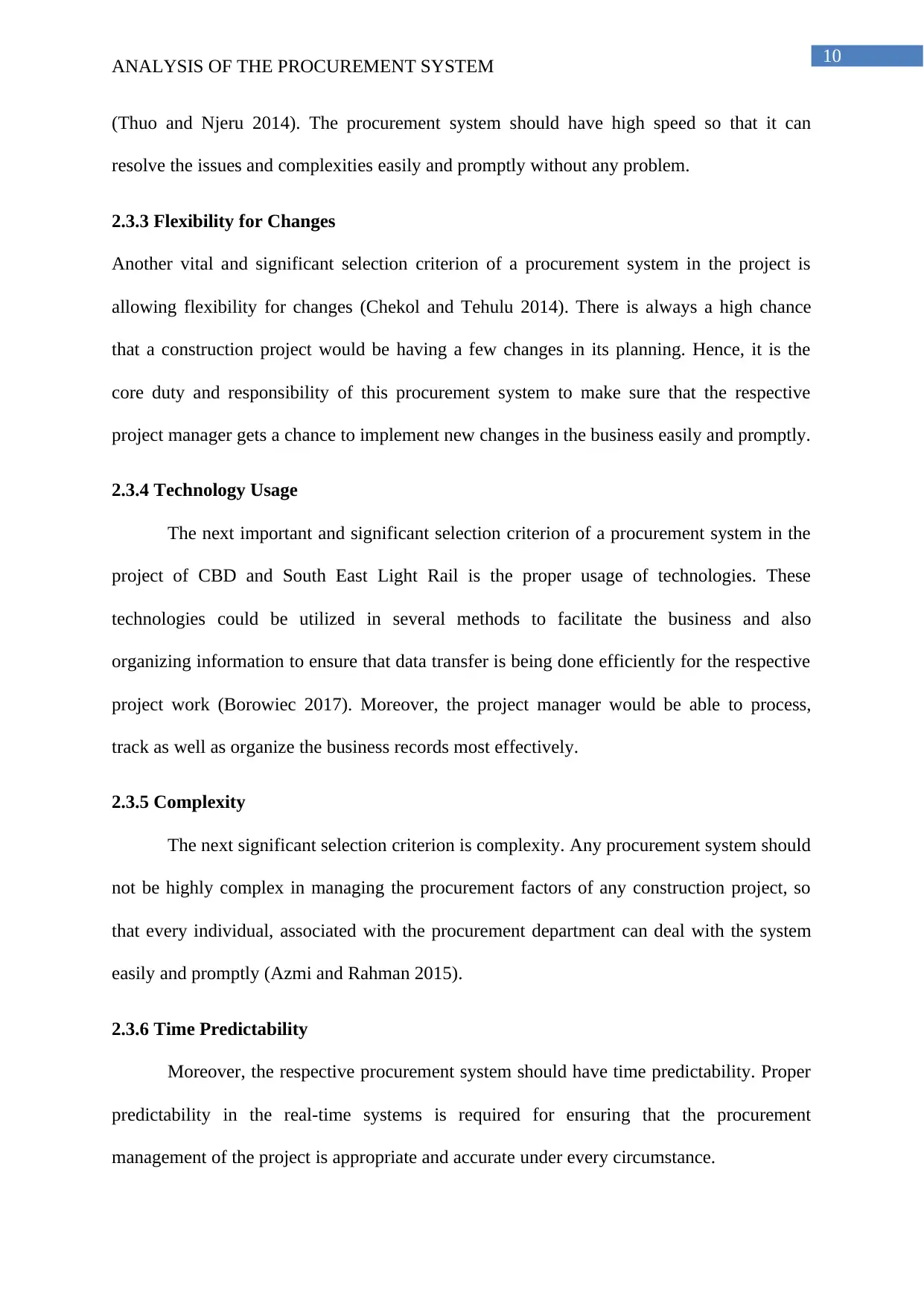
10
ANALYSIS OF THE PROCUREMENT SYSTEM
(Thuo and Njeru 2014). The procurement system should have high speed so that it can
resolve the issues and complexities easily and promptly without any problem.
2.3.3 Flexibility for Changes
Another vital and significant selection criterion of a procurement system in the project is
allowing flexibility for changes (Chekol and Tehulu 2014). There is always a high chance
that a construction project would be having a few changes in its planning. Hence, it is the
core duty and responsibility of this procurement system to make sure that the respective
project manager gets a chance to implement new changes in the business easily and promptly.
2.3.4 Technology Usage
The next important and significant selection criterion of a procurement system in the
project of CBD and South East Light Rail is the proper usage of technologies. These
technologies could be utilized in several methods to facilitate the business and also
organizing information to ensure that data transfer is being done efficiently for the respective
project work (Borowiec 2017). Moreover, the project manager would be able to process,
track as well as organize the business records most effectively.
2.3.5 Complexity
The next significant selection criterion is complexity. Any procurement system should
not be highly complex in managing the procurement factors of any construction project, so
that every individual, associated with the procurement department can deal with the system
easily and promptly (Azmi and Rahman 2015).
2.3.6 Time Predictability
Moreover, the respective procurement system should have time predictability. Proper
predictability in the real-time systems is required for ensuring that the procurement
management of the project is appropriate and accurate under every circumstance.
ANALYSIS OF THE PROCUREMENT SYSTEM
(Thuo and Njeru 2014). The procurement system should have high speed so that it can
resolve the issues and complexities easily and promptly without any problem.
2.3.3 Flexibility for Changes
Another vital and significant selection criterion of a procurement system in the project is
allowing flexibility for changes (Chekol and Tehulu 2014). There is always a high chance
that a construction project would be having a few changes in its planning. Hence, it is the
core duty and responsibility of this procurement system to make sure that the respective
project manager gets a chance to implement new changes in the business easily and promptly.
2.3.4 Technology Usage
The next important and significant selection criterion of a procurement system in the
project of CBD and South East Light Rail is the proper usage of technologies. These
technologies could be utilized in several methods to facilitate the business and also
organizing information to ensure that data transfer is being done efficiently for the respective
project work (Borowiec 2017). Moreover, the project manager would be able to process,
track as well as organize the business records most effectively.
2.3.5 Complexity
The next significant selection criterion is complexity. Any procurement system should
not be highly complex in managing the procurement factors of any construction project, so
that every individual, associated with the procurement department can deal with the system
easily and promptly (Azmi and Rahman 2015).
2.3.6 Time Predictability
Moreover, the respective procurement system should have time predictability. Proper
predictability in the real-time systems is required for ensuring that the procurement
management of the project is appropriate and accurate under every circumstance.
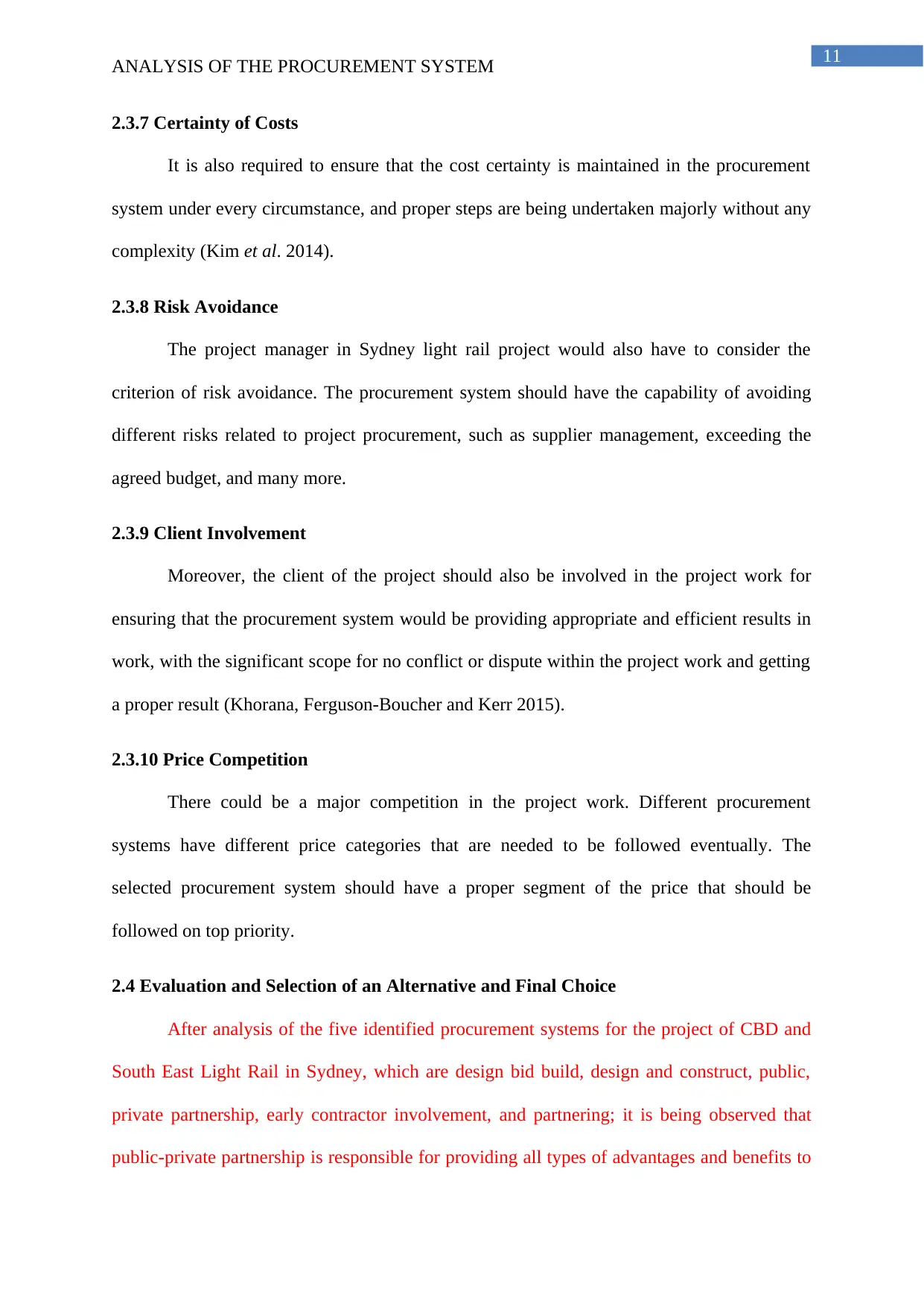
11
ANALYSIS OF THE PROCUREMENT SYSTEM
2.3.7 Certainty of Costs
It is also required to ensure that the cost certainty is maintained in the procurement
system under every circumstance, and proper steps are being undertaken majorly without any
complexity (Kim et al. 2014).
2.3.8 Risk Avoidance
The project manager in Sydney light rail project would also have to consider the
criterion of risk avoidance. The procurement system should have the capability of avoiding
different risks related to project procurement, such as supplier management, exceeding the
agreed budget, and many more.
2.3.9 Client Involvement
Moreover, the client of the project should also be involved in the project work for
ensuring that the procurement system would be providing appropriate and efficient results in
work, with the significant scope for no conflict or dispute within the project work and getting
a proper result (Khorana, Ferguson‐Boucher and Kerr 2015).
2.3.10 Price Competition
There could be a major competition in the project work. Different procurement
systems have different price categories that are needed to be followed eventually. The
selected procurement system should have a proper segment of the price that should be
followed on top priority.
2.4 Evaluation and Selection of an Alternative and Final Choice
After analysis of the five identified procurement systems for the project of CBD and
South East Light Rail in Sydney, which are design bid build, design and construct, public,
private partnership, early contractor involvement, and partnering; it is being observed that
public-private partnership is responsible for providing all types of advantages and benefits to
ANALYSIS OF THE PROCUREMENT SYSTEM
2.3.7 Certainty of Costs
It is also required to ensure that the cost certainty is maintained in the procurement
system under every circumstance, and proper steps are being undertaken majorly without any
complexity (Kim et al. 2014).
2.3.8 Risk Avoidance
The project manager in Sydney light rail project would also have to consider the
criterion of risk avoidance. The procurement system should have the capability of avoiding
different risks related to project procurement, such as supplier management, exceeding the
agreed budget, and many more.
2.3.9 Client Involvement
Moreover, the client of the project should also be involved in the project work for
ensuring that the procurement system would be providing appropriate and efficient results in
work, with the significant scope for no conflict or dispute within the project work and getting
a proper result (Khorana, Ferguson‐Boucher and Kerr 2015).
2.3.10 Price Competition
There could be a major competition in the project work. Different procurement
systems have different price categories that are needed to be followed eventually. The
selected procurement system should have a proper segment of the price that should be
followed on top priority.
2.4 Evaluation and Selection of an Alternative and Final Choice
After analysis of the five identified procurement systems for the project of CBD and
South East Light Rail in Sydney, which are design bid build, design and construct, public,
private partnership, early contractor involvement, and partnering; it is being observed that
public-private partnership is responsible for providing all types of advantages and benefits to
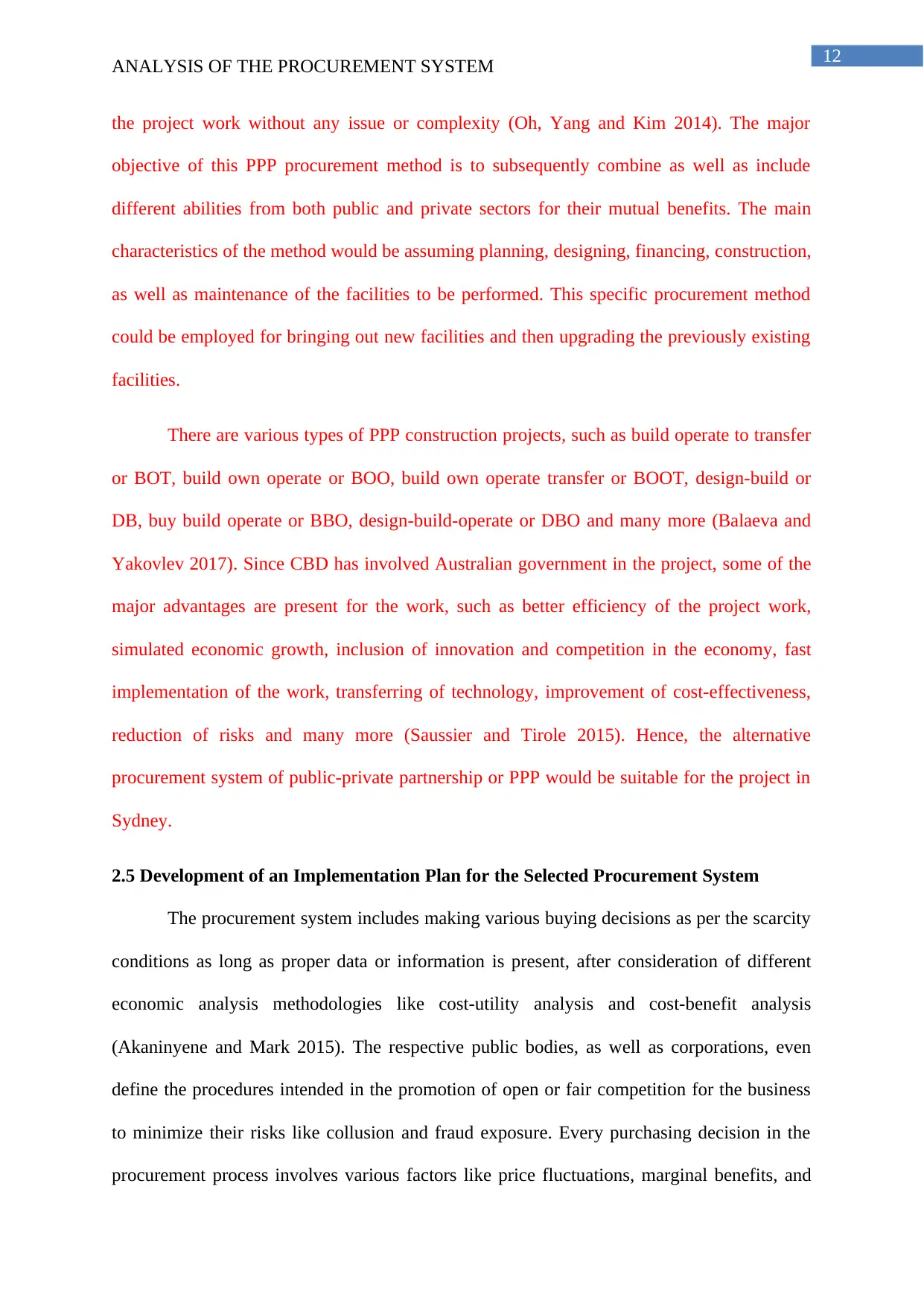
12
ANALYSIS OF THE PROCUREMENT SYSTEM
the project work without any issue or complexity (Oh, Yang and Kim 2014). The major
objective of this PPP procurement method is to subsequently combine as well as include
different abilities from both public and private sectors for their mutual benefits. The main
characteristics of the method would be assuming planning, designing, financing, construction,
as well as maintenance of the facilities to be performed. This specific procurement method
could be employed for bringing out new facilities and then upgrading the previously existing
facilities.
There are various types of PPP construction projects, such as build operate to transfer
or BOT, build own operate or BOO, build own operate transfer or BOOT, design-build or
DB, buy build operate or BBO, design-build-operate or DBO and many more (Balaeva and
Yakovlev 2017). Since CBD has involved Australian government in the project, some of the
major advantages are present for the work, such as better efficiency of the project work,
simulated economic growth, inclusion of innovation and competition in the economy, fast
implementation of the work, transferring of technology, improvement of cost-effectiveness,
reduction of risks and many more (Saussier and Tirole 2015). Hence, the alternative
procurement system of public-private partnership or PPP would be suitable for the project in
Sydney.
2.5 Development of an Implementation Plan for the Selected Procurement System
The procurement system includes making various buying decisions as per the scarcity
conditions as long as proper data or information is present, after consideration of different
economic analysis methodologies like cost-utility analysis and cost-benefit analysis
(Akaninyene and Mark 2015). The respective public bodies, as well as corporations, even
define the procedures intended in the promotion of open or fair competition for the business
to minimize their risks like collusion and fraud exposure. Every purchasing decision in the
procurement process involves various factors like price fluctuations, marginal benefits, and
ANALYSIS OF THE PROCUREMENT SYSTEM
the project work without any issue or complexity (Oh, Yang and Kim 2014). The major
objective of this PPP procurement method is to subsequently combine as well as include
different abilities from both public and private sectors for their mutual benefits. The main
characteristics of the method would be assuming planning, designing, financing, construction,
as well as maintenance of the facilities to be performed. This specific procurement method
could be employed for bringing out new facilities and then upgrading the previously existing
facilities.
There are various types of PPP construction projects, such as build operate to transfer
or BOT, build own operate or BOO, build own operate transfer or BOOT, design-build or
DB, buy build operate or BBO, design-build-operate or DBO and many more (Balaeva and
Yakovlev 2017). Since CBD has involved Australian government in the project, some of the
major advantages are present for the work, such as better efficiency of the project work,
simulated economic growth, inclusion of innovation and competition in the economy, fast
implementation of the work, transferring of technology, improvement of cost-effectiveness,
reduction of risks and many more (Saussier and Tirole 2015). Hence, the alternative
procurement system of public-private partnership or PPP would be suitable for the project in
Sydney.
2.5 Development of an Implementation Plan for the Selected Procurement System
The procurement system includes making various buying decisions as per the scarcity
conditions as long as proper data or information is present, after consideration of different
economic analysis methodologies like cost-utility analysis and cost-benefit analysis
(Akaninyene and Mark 2015). The respective public bodies, as well as corporations, even
define the procedures intended in the promotion of open or fair competition for the business
to minimize their risks like collusion and fraud exposure. Every purchasing decision in the
procurement process involves various factors like price fluctuations, marginal benefits, and
Paraphrase This Document
Need a fresh take? Get an instant paraphrase of this document with our AI Paraphraser
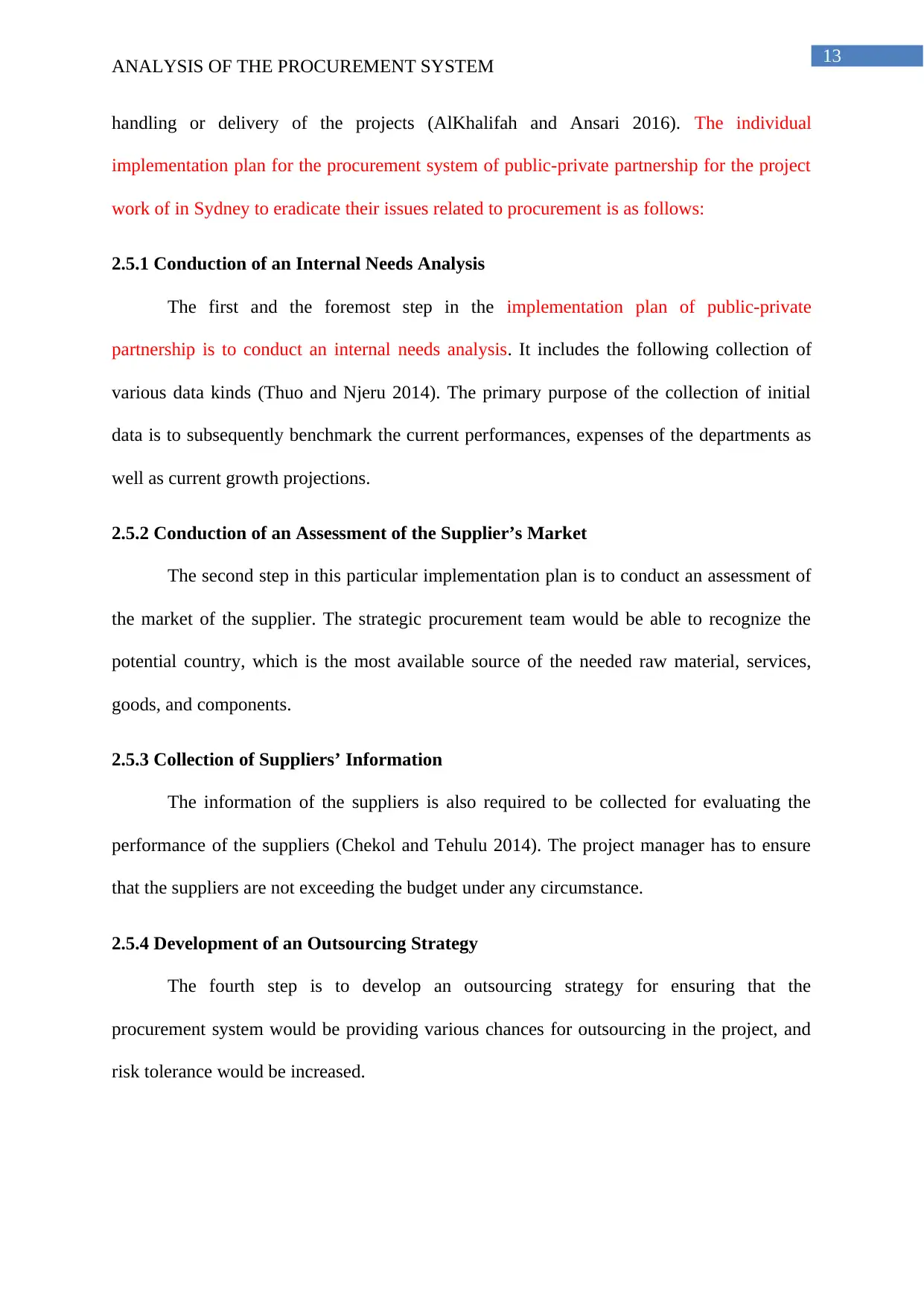
13
ANALYSIS OF THE PROCUREMENT SYSTEM
handling or delivery of the projects (AlKhalifah and Ansari 2016). The individual
implementation plan for the procurement system of public-private partnership for the project
work of in Sydney to eradicate their issues related to procurement is as follows:
2.5.1 Conduction of an Internal Needs Analysis
The first and the foremost step in the implementation plan of public-private
partnership is to conduct an internal needs analysis. It includes the following collection of
various data kinds (Thuo and Njeru 2014). The primary purpose of the collection of initial
data is to subsequently benchmark the current performances, expenses of the departments as
well as current growth projections.
2.5.2 Conduction of an Assessment of the Supplier’s Market
The second step in this particular implementation plan is to conduct an assessment of
the market of the supplier. The strategic procurement team would be able to recognize the
potential country, which is the most available source of the needed raw material, services,
goods, and components.
2.5.3 Collection of Suppliers’ Information
The information of the suppliers is also required to be collected for evaluating the
performance of the suppliers (Chekol and Tehulu 2014). The project manager has to ensure
that the suppliers are not exceeding the budget under any circumstance.
2.5.4 Development of an Outsourcing Strategy
The fourth step is to develop an outsourcing strategy for ensuring that the
procurement system would be providing various chances for outsourcing in the project, and
risk tolerance would be increased.
ANALYSIS OF THE PROCUREMENT SYSTEM
handling or delivery of the projects (AlKhalifah and Ansari 2016). The individual
implementation plan for the procurement system of public-private partnership for the project
work of in Sydney to eradicate their issues related to procurement is as follows:
2.5.1 Conduction of an Internal Needs Analysis
The first and the foremost step in the implementation plan of public-private
partnership is to conduct an internal needs analysis. It includes the following collection of
various data kinds (Thuo and Njeru 2014). The primary purpose of the collection of initial
data is to subsequently benchmark the current performances, expenses of the departments as
well as current growth projections.
2.5.2 Conduction of an Assessment of the Supplier’s Market
The second step in this particular implementation plan is to conduct an assessment of
the market of the supplier. The strategic procurement team would be able to recognize the
potential country, which is the most available source of the needed raw material, services,
goods, and components.
2.5.3 Collection of Suppliers’ Information
The information of the suppliers is also required to be collected for evaluating the
performance of the suppliers (Chekol and Tehulu 2014). The project manager has to ensure
that the suppliers are not exceeding the budget under any circumstance.
2.5.4 Development of an Outsourcing Strategy
The fourth step is to develop an outsourcing strategy for ensuring that the
procurement system would be providing various chances for outsourcing in the project, and
risk tolerance would be increased.
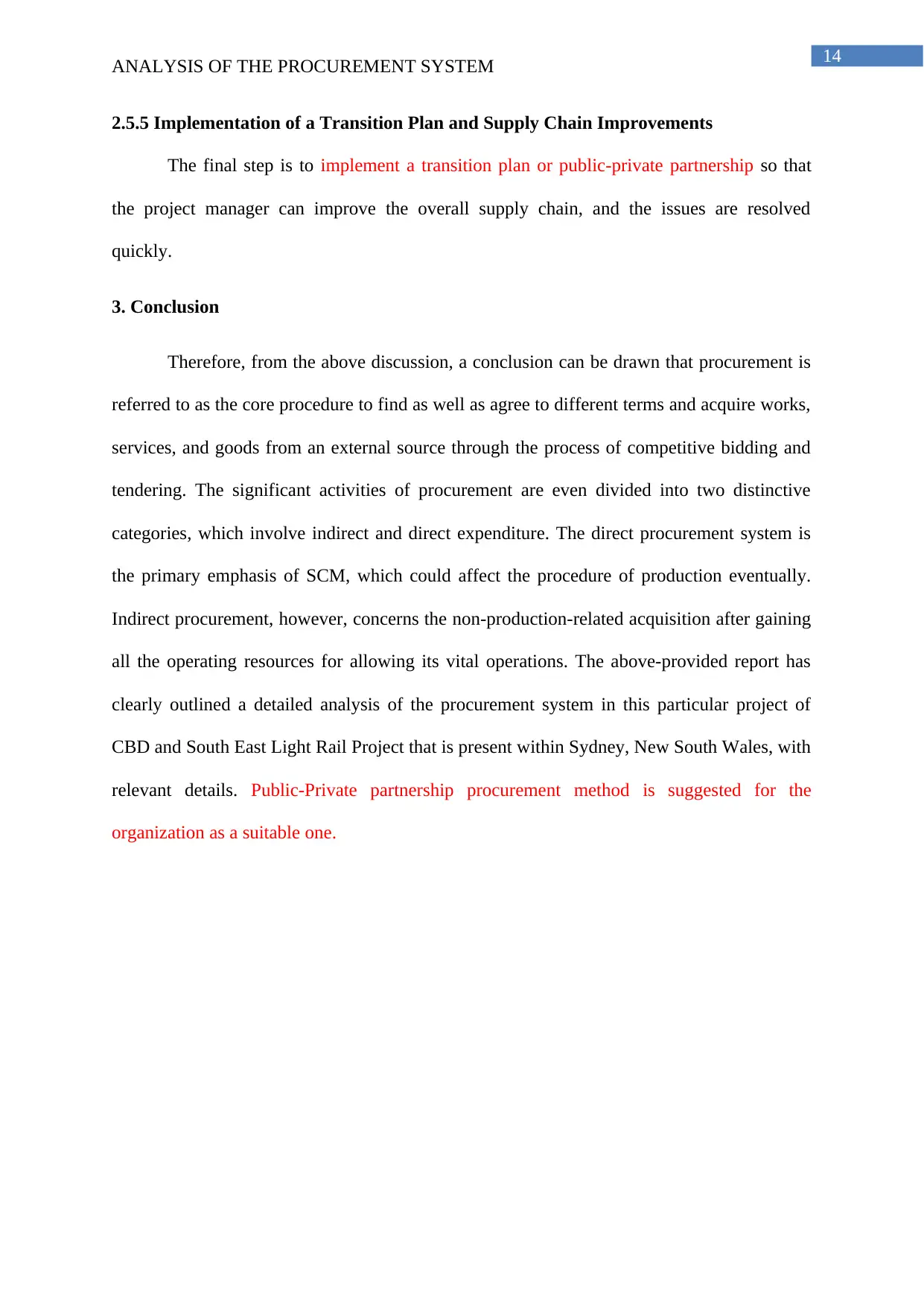
14
ANALYSIS OF THE PROCUREMENT SYSTEM
2.5.5 Implementation of a Transition Plan and Supply Chain Improvements
The final step is to implement a transition plan or public-private partnership so that
the project manager can improve the overall supply chain, and the issues are resolved
quickly.
3. Conclusion
Therefore, from the above discussion, a conclusion can be drawn that procurement is
referred to as the core procedure to find as well as agree to different terms and acquire works,
services, and goods from an external source through the process of competitive bidding and
tendering. The significant activities of procurement are even divided into two distinctive
categories, which involve indirect and direct expenditure. The direct procurement system is
the primary emphasis of SCM, which could affect the procedure of production eventually.
Indirect procurement, however, concerns the non-production-related acquisition after gaining
all the operating resources for allowing its vital operations. The above-provided report has
clearly outlined a detailed analysis of the procurement system in this particular project of
CBD and South East Light Rail Project that is present within Sydney, New South Wales, with
relevant details. Public-Private partnership procurement method is suggested for the
organization as a suitable one.
ANALYSIS OF THE PROCUREMENT SYSTEM
2.5.5 Implementation of a Transition Plan and Supply Chain Improvements
The final step is to implement a transition plan or public-private partnership so that
the project manager can improve the overall supply chain, and the issues are resolved
quickly.
3. Conclusion
Therefore, from the above discussion, a conclusion can be drawn that procurement is
referred to as the core procedure to find as well as agree to different terms and acquire works,
services, and goods from an external source through the process of competitive bidding and
tendering. The significant activities of procurement are even divided into two distinctive
categories, which involve indirect and direct expenditure. The direct procurement system is
the primary emphasis of SCM, which could affect the procedure of production eventually.
Indirect procurement, however, concerns the non-production-related acquisition after gaining
all the operating resources for allowing its vital operations. The above-provided report has
clearly outlined a detailed analysis of the procurement system in this particular project of
CBD and South East Light Rail Project that is present within Sydney, New South Wales, with
relevant details. Public-Private partnership procurement method is suggested for the
organization as a suitable one.
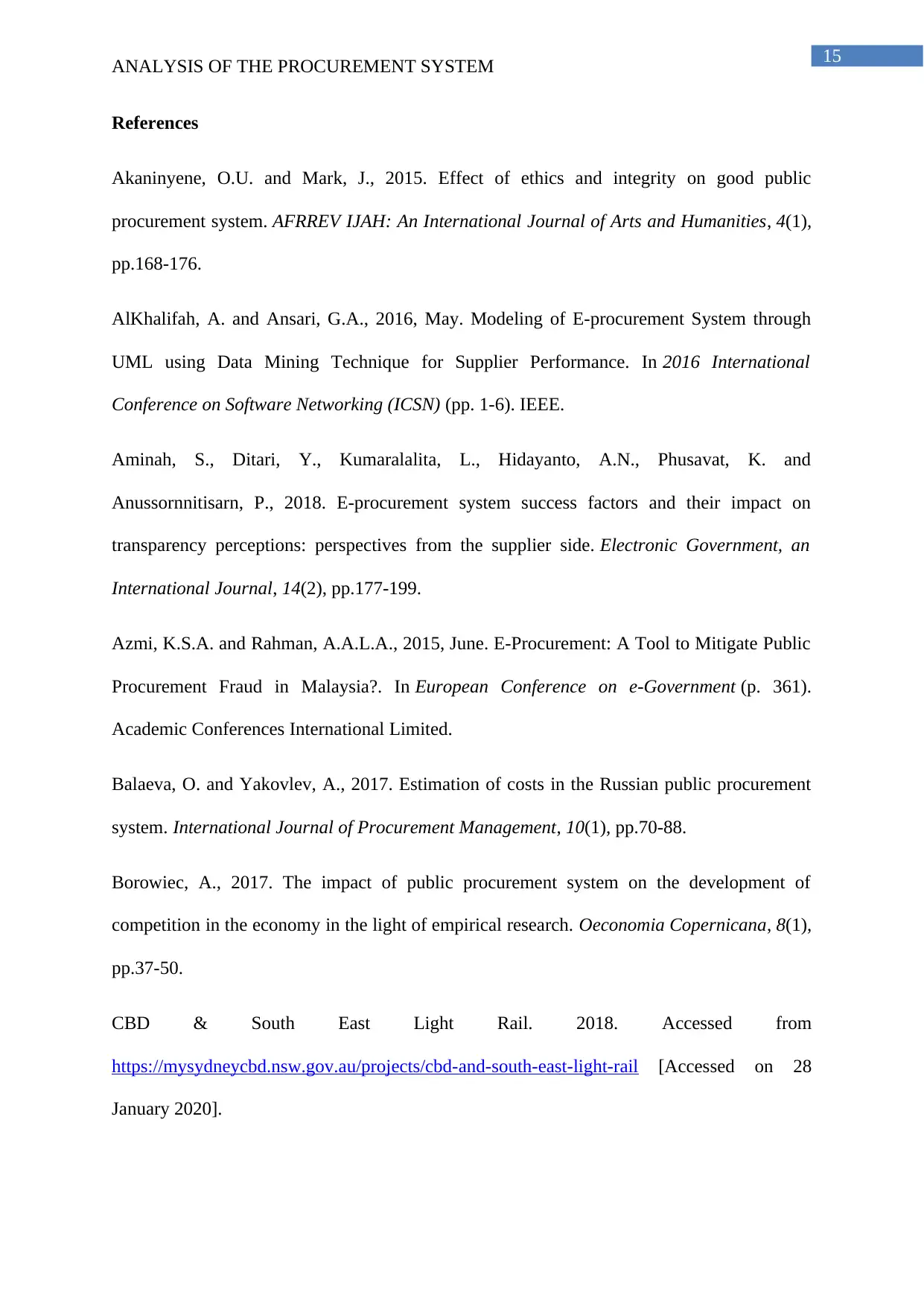
15
ANALYSIS OF THE PROCUREMENT SYSTEM
References
Akaninyene, O.U. and Mark, J., 2015. Effect of ethics and integrity on good public
procurement system. AFRREV IJAH: An International Journal of Arts and Humanities, 4(1),
pp.168-176.
AlKhalifah, A. and Ansari, G.A., 2016, May. Modeling of E-procurement System through
UML using Data Mining Technique for Supplier Performance. In 2016 International
Conference on Software Networking (ICSN) (pp. 1-6). IEEE.
Aminah, S., Ditari, Y., Kumaralalita, L., Hidayanto, A.N., Phusavat, K. and
Anussornnitisarn, P., 2018. E-procurement system success factors and their impact on
transparency perceptions: perspectives from the supplier side. Electronic Government, an
International Journal, 14(2), pp.177-199.
Azmi, K.S.A. and Rahman, A.A.L.A., 2015, June. E-Procurement: A Tool to Mitigate Public
Procurement Fraud in Malaysia?. In European Conference on e-Government (p. 361).
Academic Conferences International Limited.
Balaeva, O. and Yakovlev, A., 2017. Estimation of costs in the Russian public procurement
system. International Journal of Procurement Management, 10(1), pp.70-88.
Borowiec, A., 2017. The impact of public procurement system on the development of
competition in the economy in the light of empirical research. Oeconomia Copernicana, 8(1),
pp.37-50.
CBD & South East Light Rail. 2018. Accessed from
https://mysydneycbd.nsw.gov.au/projects/cbd-and-south-east-light-rail [Accessed on 28
January 2020].
ANALYSIS OF THE PROCUREMENT SYSTEM
References
Akaninyene, O.U. and Mark, J., 2015. Effect of ethics and integrity on good public
procurement system. AFRREV IJAH: An International Journal of Arts and Humanities, 4(1),
pp.168-176.
AlKhalifah, A. and Ansari, G.A., 2016, May. Modeling of E-procurement System through
UML using Data Mining Technique for Supplier Performance. In 2016 International
Conference on Software Networking (ICSN) (pp. 1-6). IEEE.
Aminah, S., Ditari, Y., Kumaralalita, L., Hidayanto, A.N., Phusavat, K. and
Anussornnitisarn, P., 2018. E-procurement system success factors and their impact on
transparency perceptions: perspectives from the supplier side. Electronic Government, an
International Journal, 14(2), pp.177-199.
Azmi, K.S.A. and Rahman, A.A.L.A., 2015, June. E-Procurement: A Tool to Mitigate Public
Procurement Fraud in Malaysia?. In European Conference on e-Government (p. 361).
Academic Conferences International Limited.
Balaeva, O. and Yakovlev, A., 2017. Estimation of costs in the Russian public procurement
system. International Journal of Procurement Management, 10(1), pp.70-88.
Borowiec, A., 2017. The impact of public procurement system on the development of
competition in the economy in the light of empirical research. Oeconomia Copernicana, 8(1),
pp.37-50.
CBD & South East Light Rail. 2018. Accessed from
https://mysydneycbd.nsw.gov.au/projects/cbd-and-south-east-light-rail [Accessed on 28
January 2020].
Secure Best Marks with AI Grader
Need help grading? Try our AI Grader for instant feedback on your assignments.
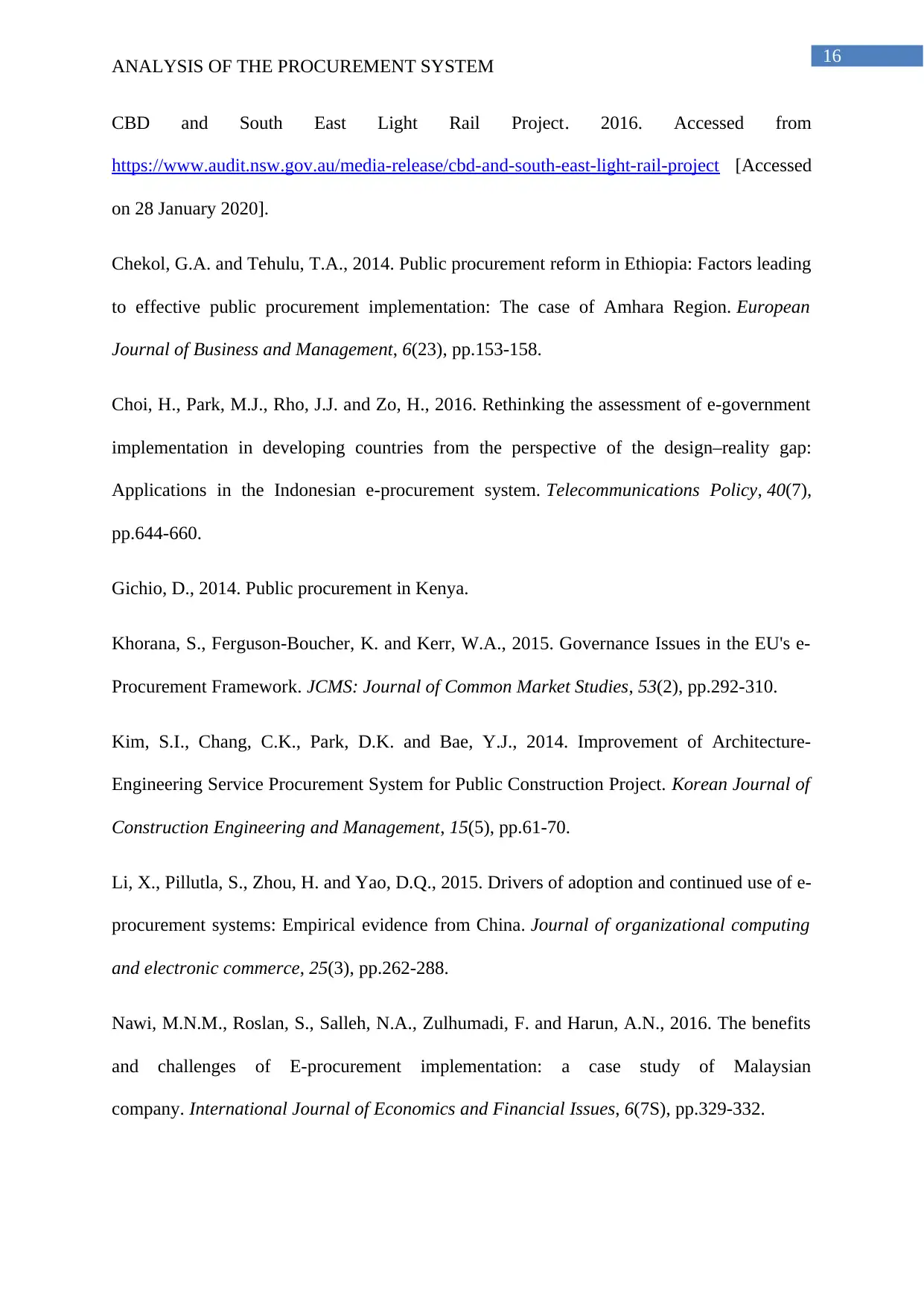
16
ANALYSIS OF THE PROCUREMENT SYSTEM
CBD and South East Light Rail Project. 2016. Accessed from
https://www.audit.nsw.gov.au/media-release/cbd-and-south-east-light-rail-project [Accessed
on 28 January 2020].
Chekol, G.A. and Tehulu, T.A., 2014. Public procurement reform in Ethiopia: Factors leading
to effective public procurement implementation: The case of Amhara Region. European
Journal of Business and Management, 6(23), pp.153-158.
Choi, H., Park, M.J., Rho, J.J. and Zo, H., 2016. Rethinking the assessment of e-government
implementation in developing countries from the perspective of the design–reality gap:
Applications in the Indonesian e-procurement system. Telecommunications Policy, 40(7),
pp.644-660.
Gichio, D., 2014. Public procurement in Kenya.
Khorana, S., Ferguson‐Boucher, K. and Kerr, W.A., 2015. Governance Issues in the EU's e‐
Procurement Framework. JCMS: Journal of Common Market Studies, 53(2), pp.292-310.
Kim, S.I., Chang, C.K., Park, D.K. and Bae, Y.J., 2014. Improvement of Architecture-
Engineering Service Procurement System for Public Construction Project. Korean Journal of
Construction Engineering and Management, 15(5), pp.61-70.
Li, X., Pillutla, S., Zhou, H. and Yao, D.Q., 2015. Drivers of adoption and continued use of e-
procurement systems: Empirical evidence from China. Journal of organizational computing
and electronic commerce, 25(3), pp.262-288.
Nawi, M.N.M., Roslan, S., Salleh, N.A., Zulhumadi, F. and Harun, A.N., 2016. The benefits
and challenges of E-procurement implementation: a case study of Malaysian
company. International Journal of Economics and Financial Issues, 6(7S), pp.329-332.
ANALYSIS OF THE PROCUREMENT SYSTEM
CBD and South East Light Rail Project. 2016. Accessed from
https://www.audit.nsw.gov.au/media-release/cbd-and-south-east-light-rail-project [Accessed
on 28 January 2020].
Chekol, G.A. and Tehulu, T.A., 2014. Public procurement reform in Ethiopia: Factors leading
to effective public procurement implementation: The case of Amhara Region. European
Journal of Business and Management, 6(23), pp.153-158.
Choi, H., Park, M.J., Rho, J.J. and Zo, H., 2016. Rethinking the assessment of e-government
implementation in developing countries from the perspective of the design–reality gap:
Applications in the Indonesian e-procurement system. Telecommunications Policy, 40(7),
pp.644-660.
Gichio, D., 2014. Public procurement in Kenya.
Khorana, S., Ferguson‐Boucher, K. and Kerr, W.A., 2015. Governance Issues in the EU's e‐
Procurement Framework. JCMS: Journal of Common Market Studies, 53(2), pp.292-310.
Kim, S.I., Chang, C.K., Park, D.K. and Bae, Y.J., 2014. Improvement of Architecture-
Engineering Service Procurement System for Public Construction Project. Korean Journal of
Construction Engineering and Management, 15(5), pp.61-70.
Li, X., Pillutla, S., Zhou, H. and Yao, D.Q., 2015. Drivers of adoption and continued use of e-
procurement systems: Empirical evidence from China. Journal of organizational computing
and electronic commerce, 25(3), pp.262-288.
Nawi, M.N.M., Roslan, S., Salleh, N.A., Zulhumadi, F. and Harun, A.N., 2016. The benefits
and challenges of E-procurement implementation: a case study of Malaysian
company. International Journal of Economics and Financial Issues, 6(7S), pp.329-332.
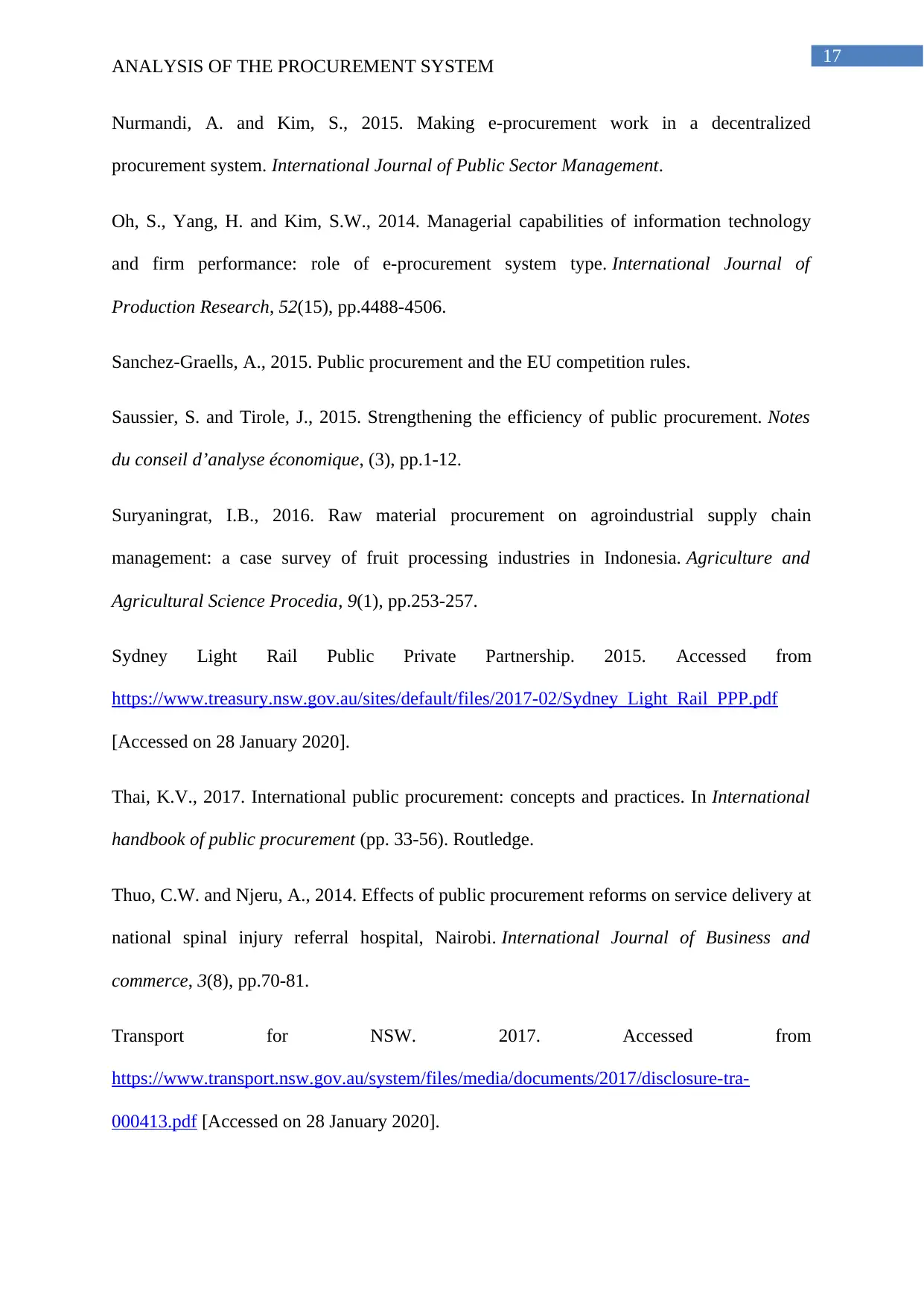
17
ANALYSIS OF THE PROCUREMENT SYSTEM
Nurmandi, A. and Kim, S., 2015. Making e-procurement work in a decentralized
procurement system. International Journal of Public Sector Management.
Oh, S., Yang, H. and Kim, S.W., 2014. Managerial capabilities of information technology
and firm performance: role of e-procurement system type. International Journal of
Production Research, 52(15), pp.4488-4506.
Sanchez-Graells, A., 2015. Public procurement and the EU competition rules.
Saussier, S. and Tirole, J., 2015. Strengthening the efficiency of public procurement. Notes
du conseil d’analyse économique, (3), pp.1-12.
Suryaningrat, I.B., 2016. Raw material procurement on agroindustrial supply chain
management: a case survey of fruit processing industries in Indonesia. Agriculture and
Agricultural Science Procedia, 9(1), pp.253-257.
Sydney Light Rail Public Private Partnership. 2015. Accessed from
https://www.treasury.nsw.gov.au/sites/default/files/2017-02/Sydney_Light_Rail_PPP.pdf
[Accessed on 28 January 2020].
Thai, K.V., 2017. International public procurement: concepts and practices. In International
handbook of public procurement (pp. 33-56). Routledge.
Thuo, C.W. and Njeru, A., 2014. Effects of public procurement reforms on service delivery at
national spinal injury referral hospital, Nairobi. International Journal of Business and
commerce, 3(8), pp.70-81.
Transport for NSW. 2017. Accessed from
https://www.transport.nsw.gov.au/system/files/media/documents/2017/disclosure-tra-
000413.pdf [Accessed on 28 January 2020].
ANALYSIS OF THE PROCUREMENT SYSTEM
Nurmandi, A. and Kim, S., 2015. Making e-procurement work in a decentralized
procurement system. International Journal of Public Sector Management.
Oh, S., Yang, H. and Kim, S.W., 2014. Managerial capabilities of information technology
and firm performance: role of e-procurement system type. International Journal of
Production Research, 52(15), pp.4488-4506.
Sanchez-Graells, A., 2015. Public procurement and the EU competition rules.
Saussier, S. and Tirole, J., 2015. Strengthening the efficiency of public procurement. Notes
du conseil d’analyse économique, (3), pp.1-12.
Suryaningrat, I.B., 2016. Raw material procurement on agroindustrial supply chain
management: a case survey of fruit processing industries in Indonesia. Agriculture and
Agricultural Science Procedia, 9(1), pp.253-257.
Sydney Light Rail Public Private Partnership. 2015. Accessed from
https://www.treasury.nsw.gov.au/sites/default/files/2017-02/Sydney_Light_Rail_PPP.pdf
[Accessed on 28 January 2020].
Thai, K.V., 2017. International public procurement: concepts and practices. In International
handbook of public procurement (pp. 33-56). Routledge.
Thuo, C.W. and Njeru, A., 2014. Effects of public procurement reforms on service delivery at
national spinal injury referral hospital, Nairobi. International Journal of Business and
commerce, 3(8), pp.70-81.
Transport for NSW. 2017. Accessed from
https://www.transport.nsw.gov.au/system/files/media/documents/2017/disclosure-tra-
000413.pdf [Accessed on 28 January 2020].
1 out of 18
Related Documents
Your All-in-One AI-Powered Toolkit for Academic Success.
+13062052269
info@desklib.com
Available 24*7 on WhatsApp / Email
![[object Object]](/_next/static/media/star-bottom.7253800d.svg)
Unlock your academic potential
© 2024 | Zucol Services PVT LTD | All rights reserved.





